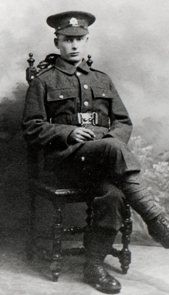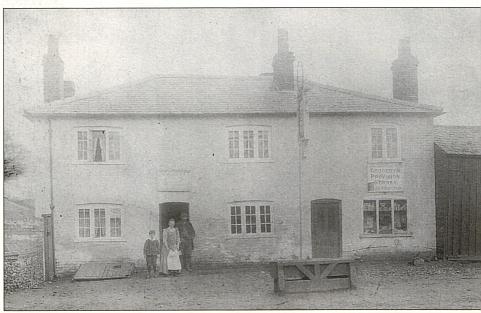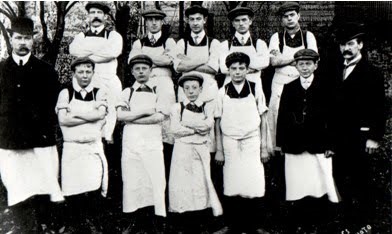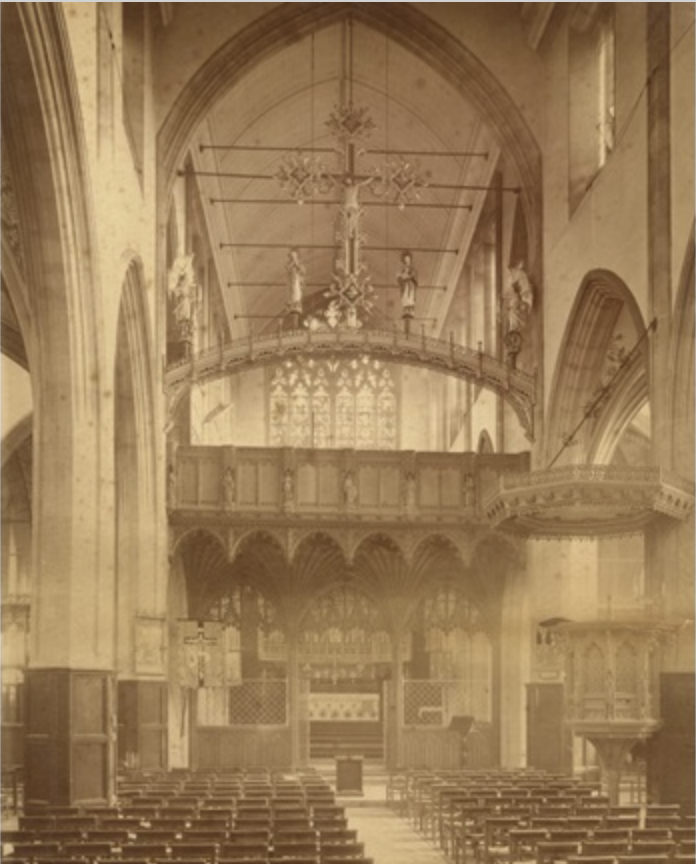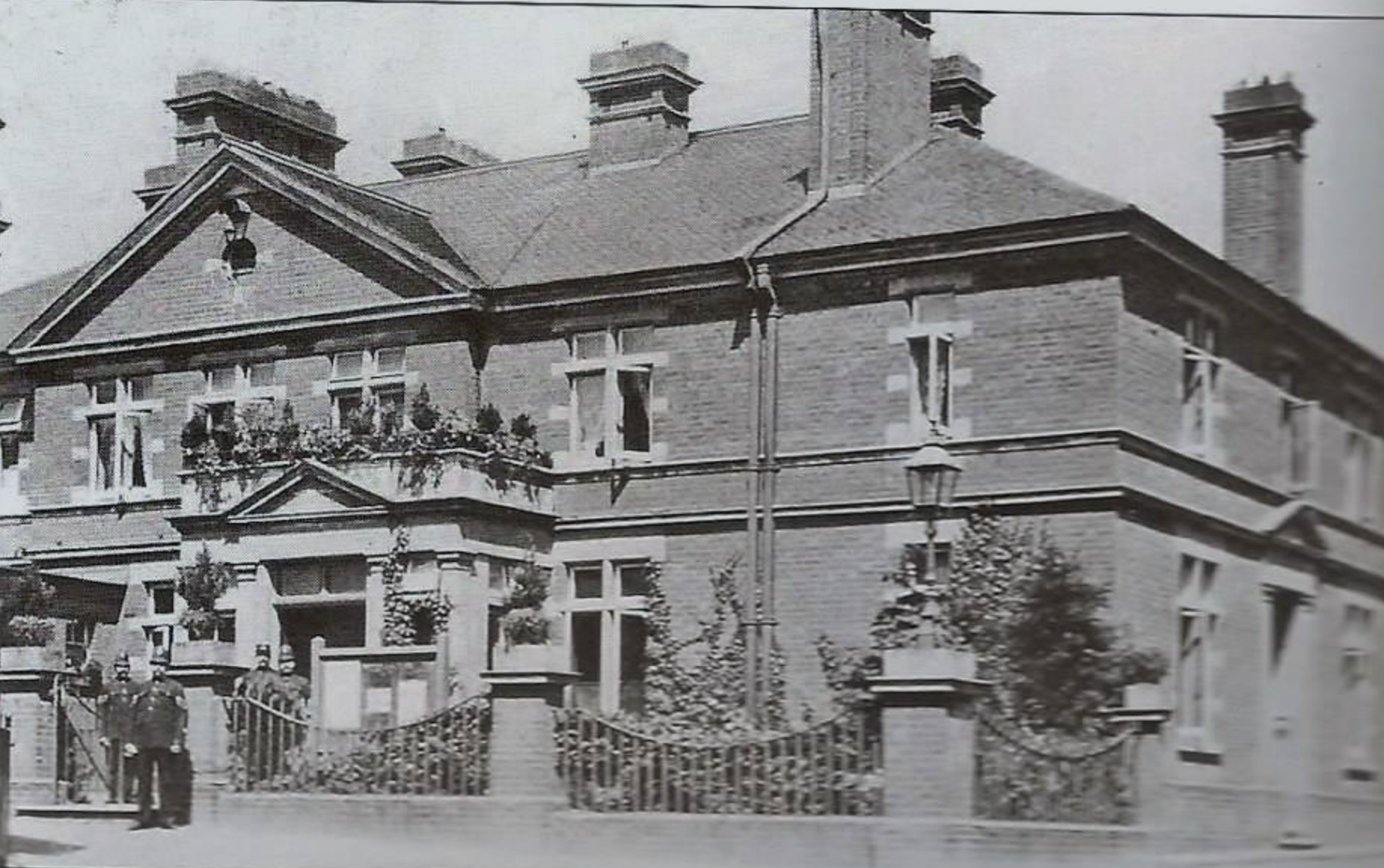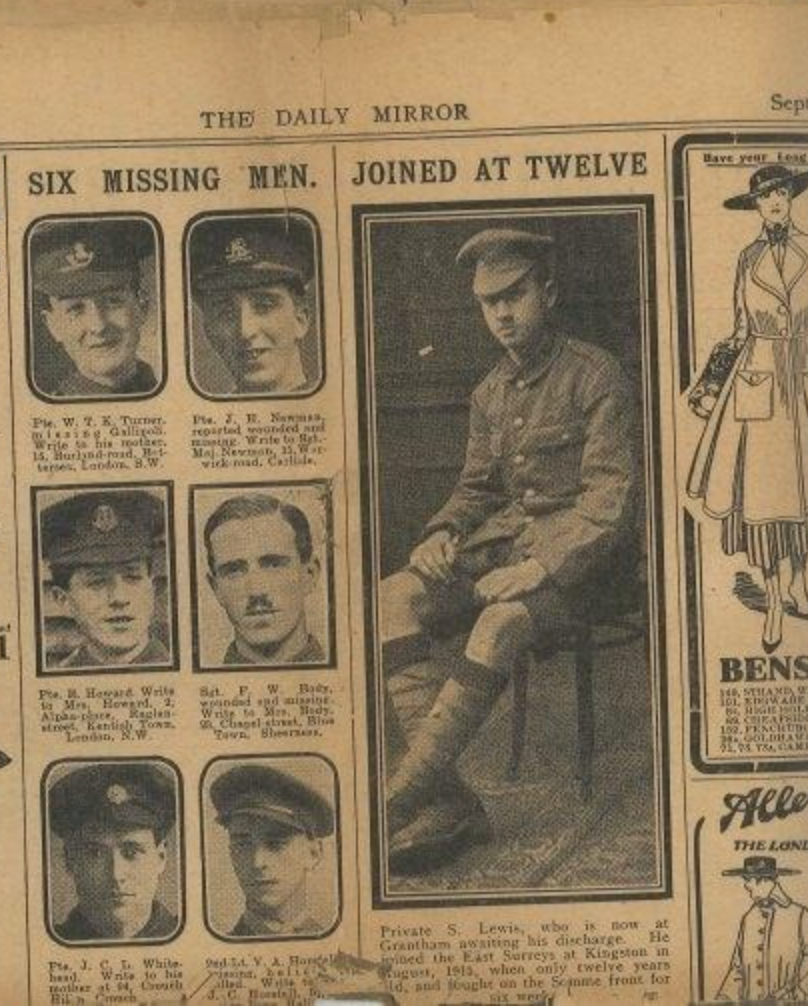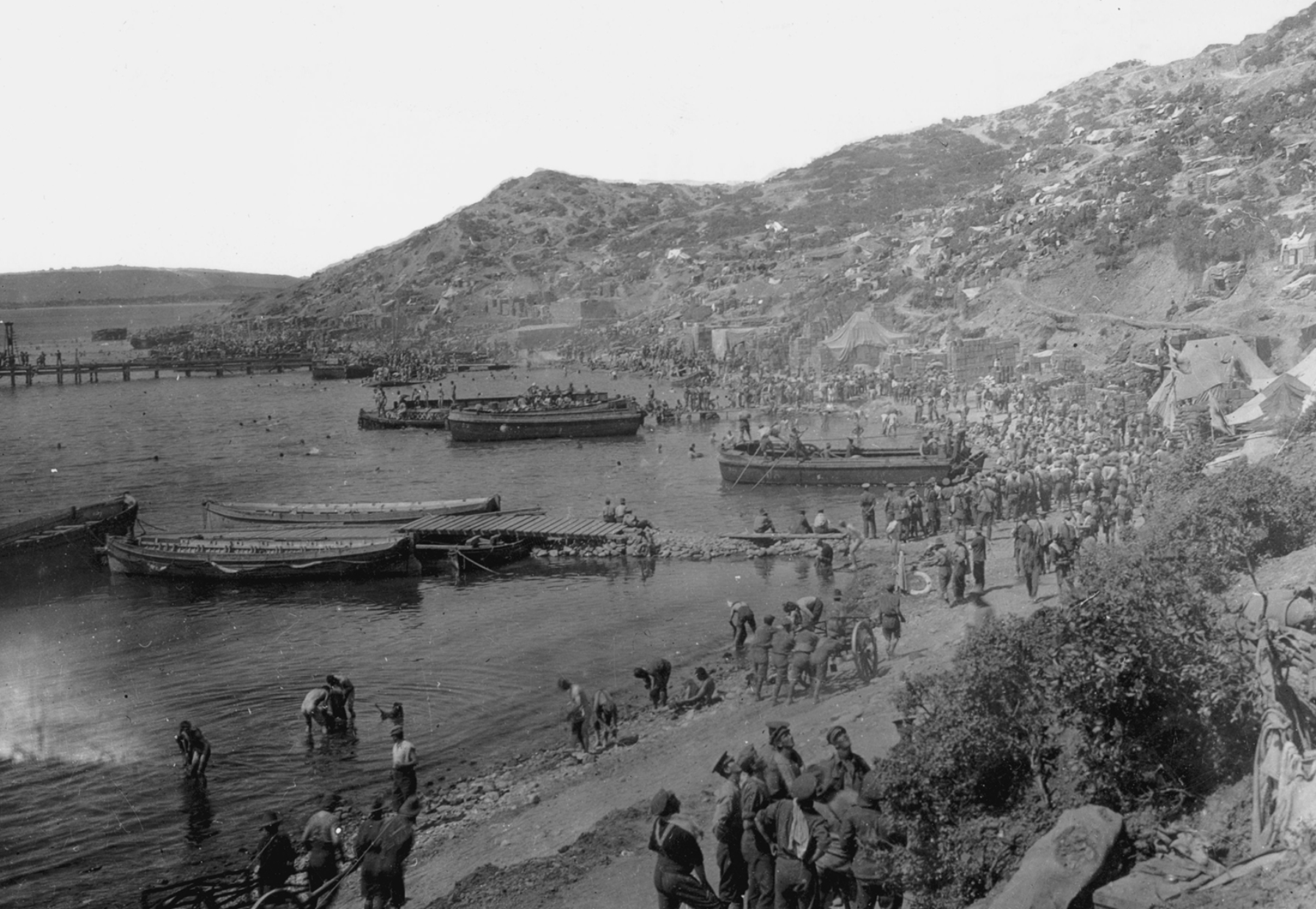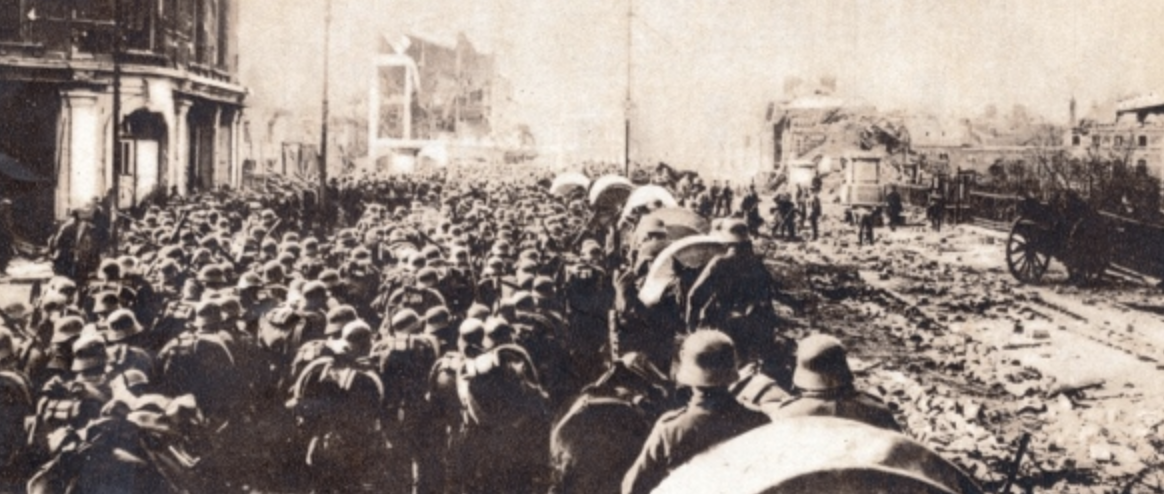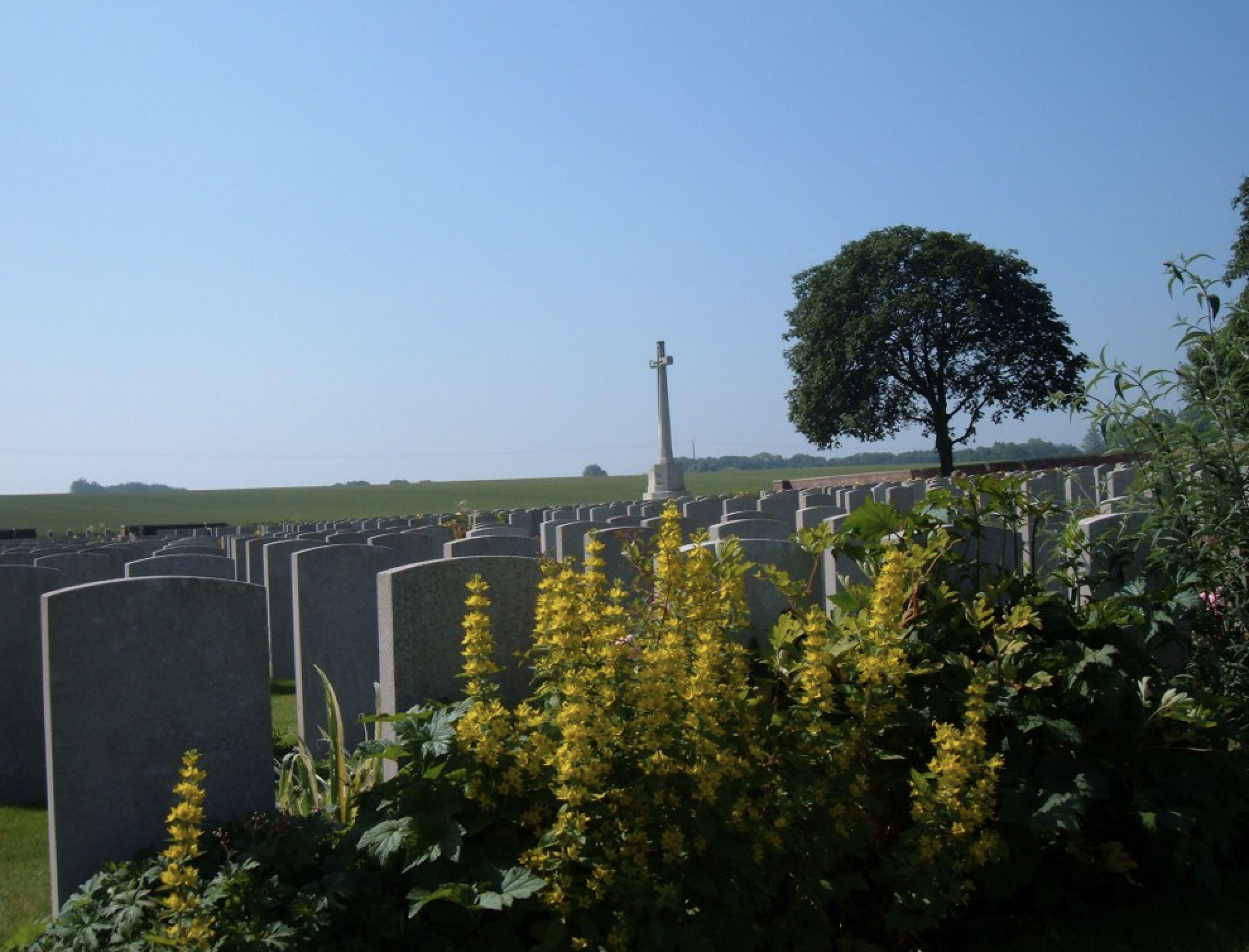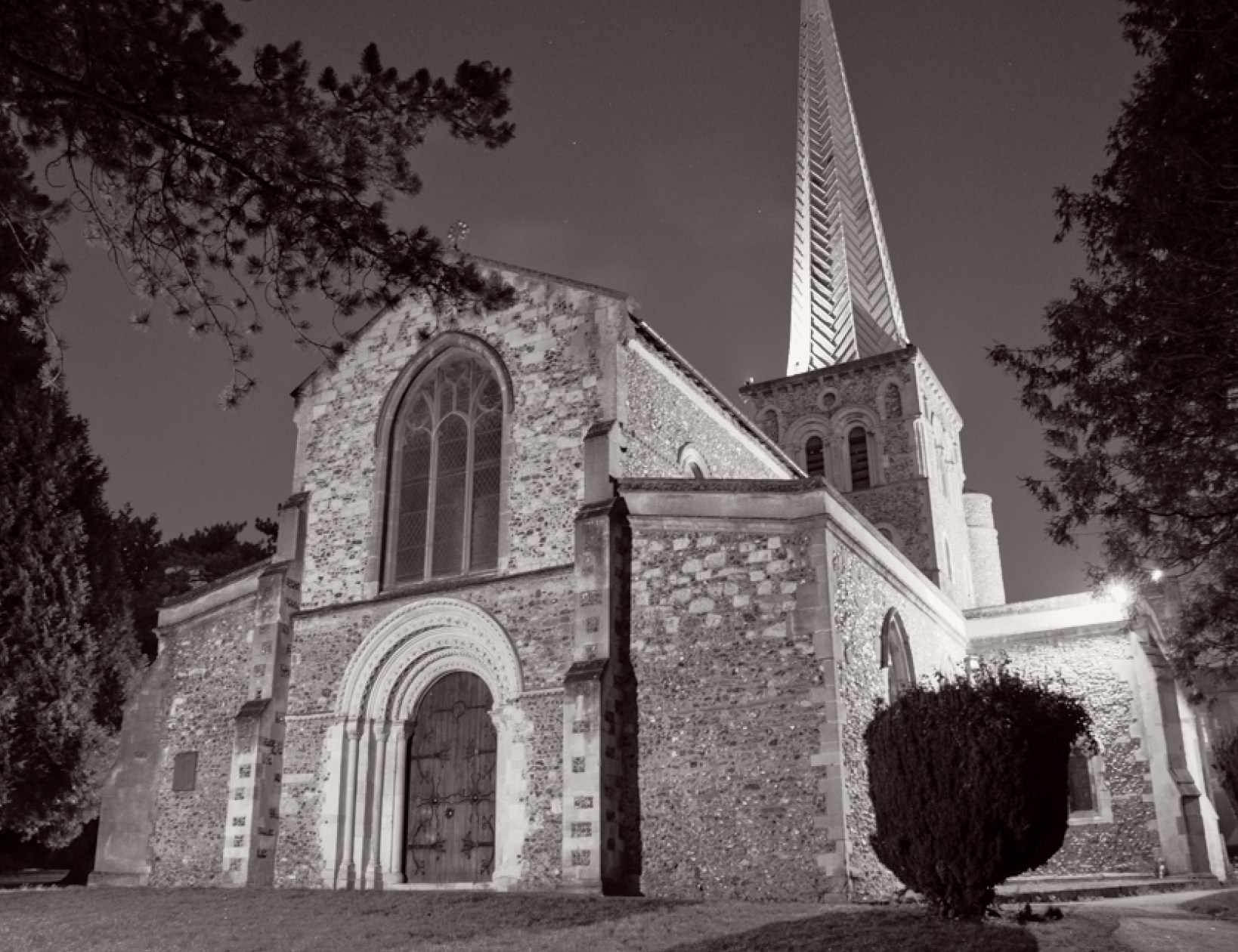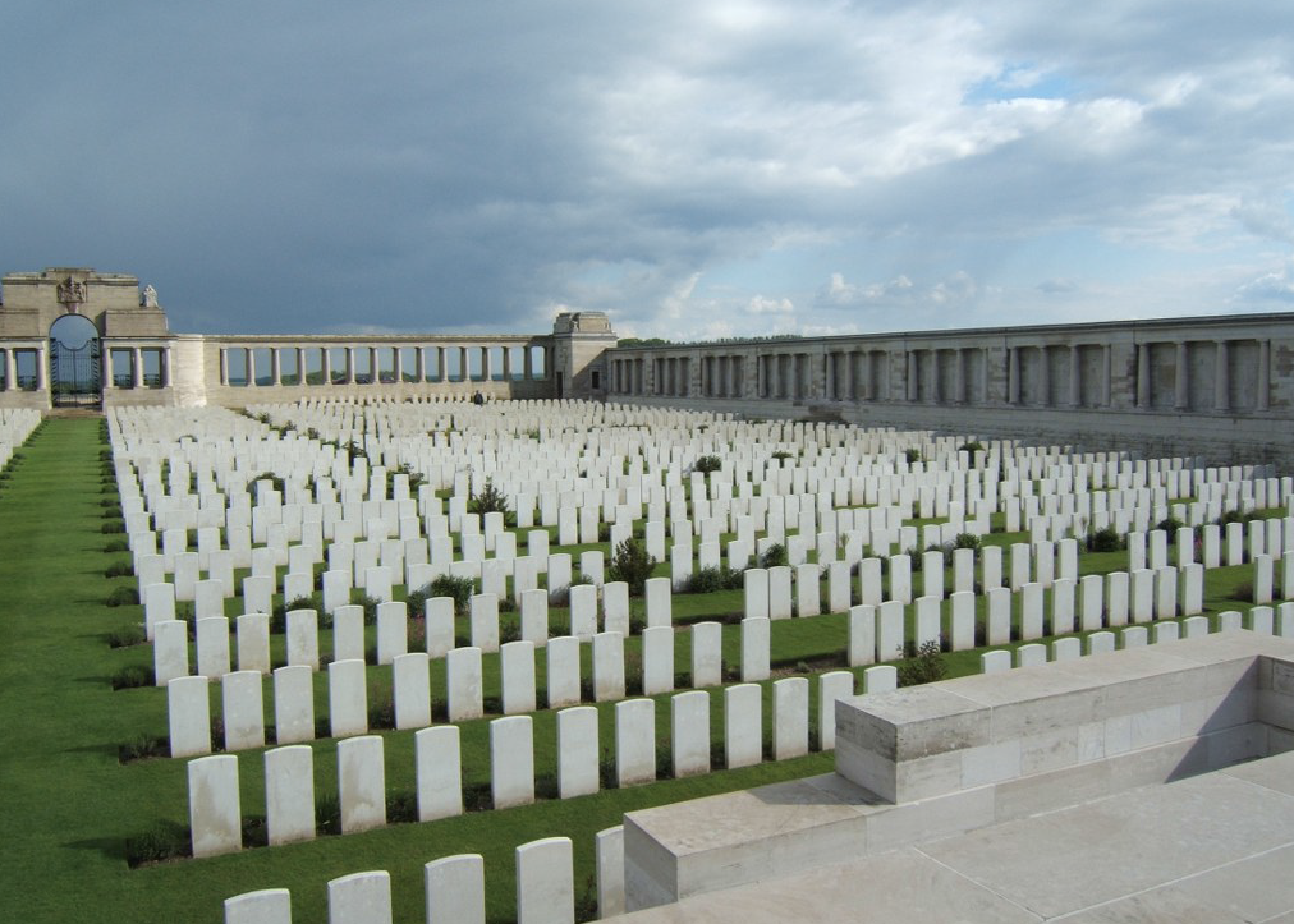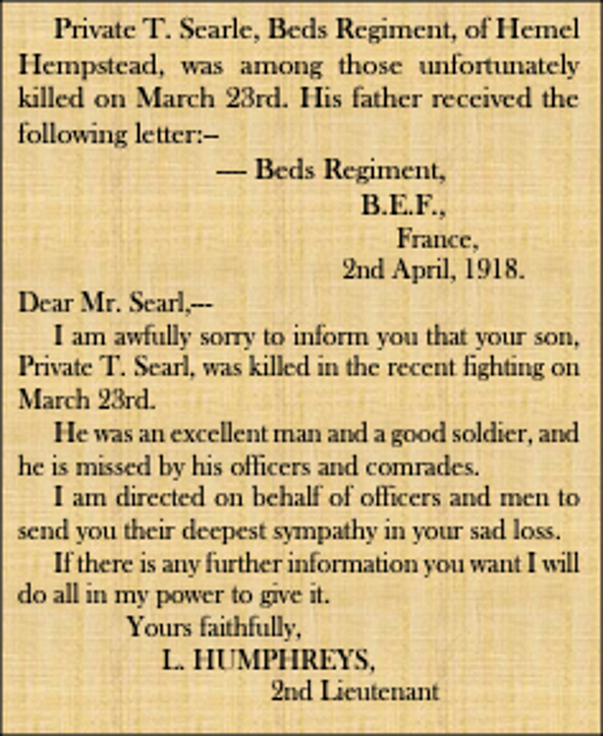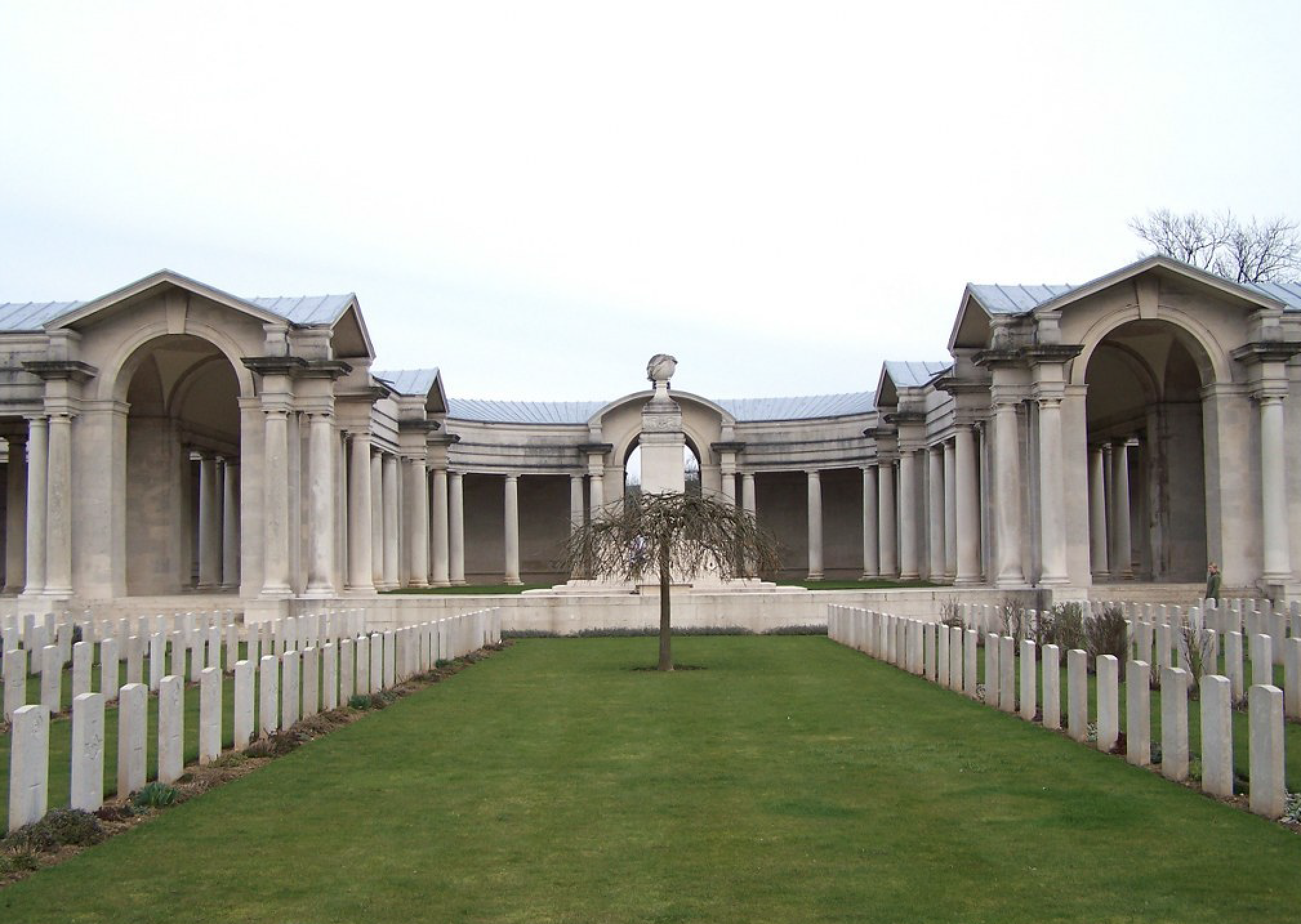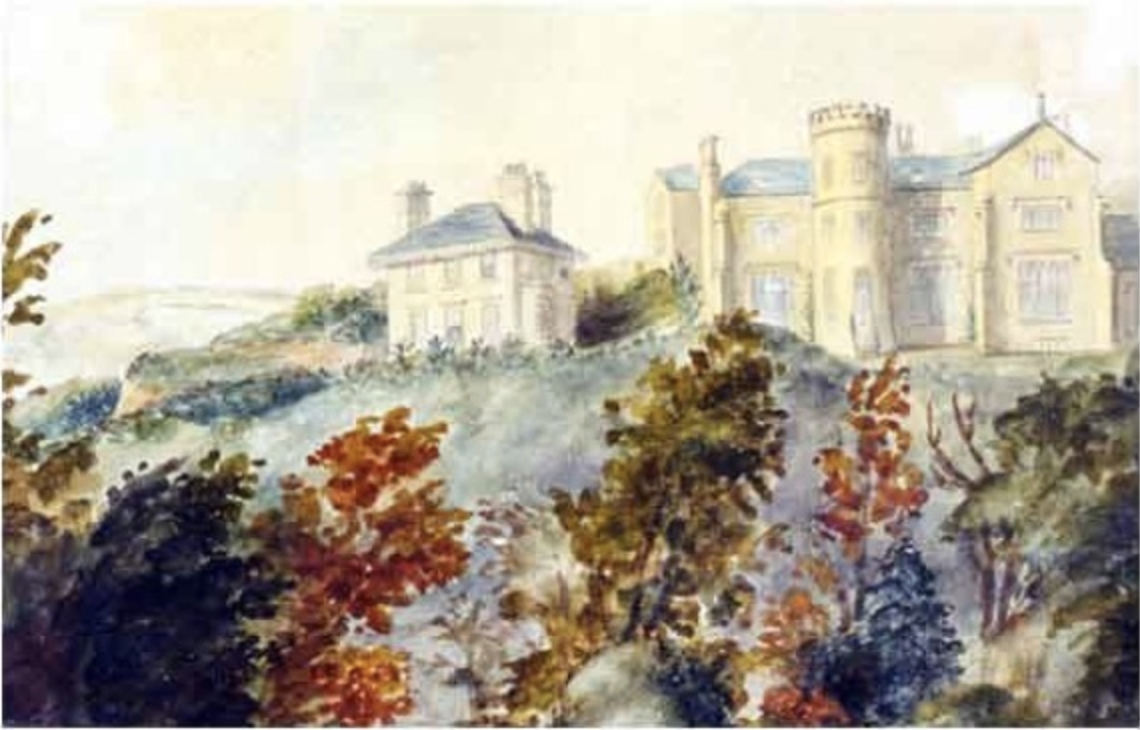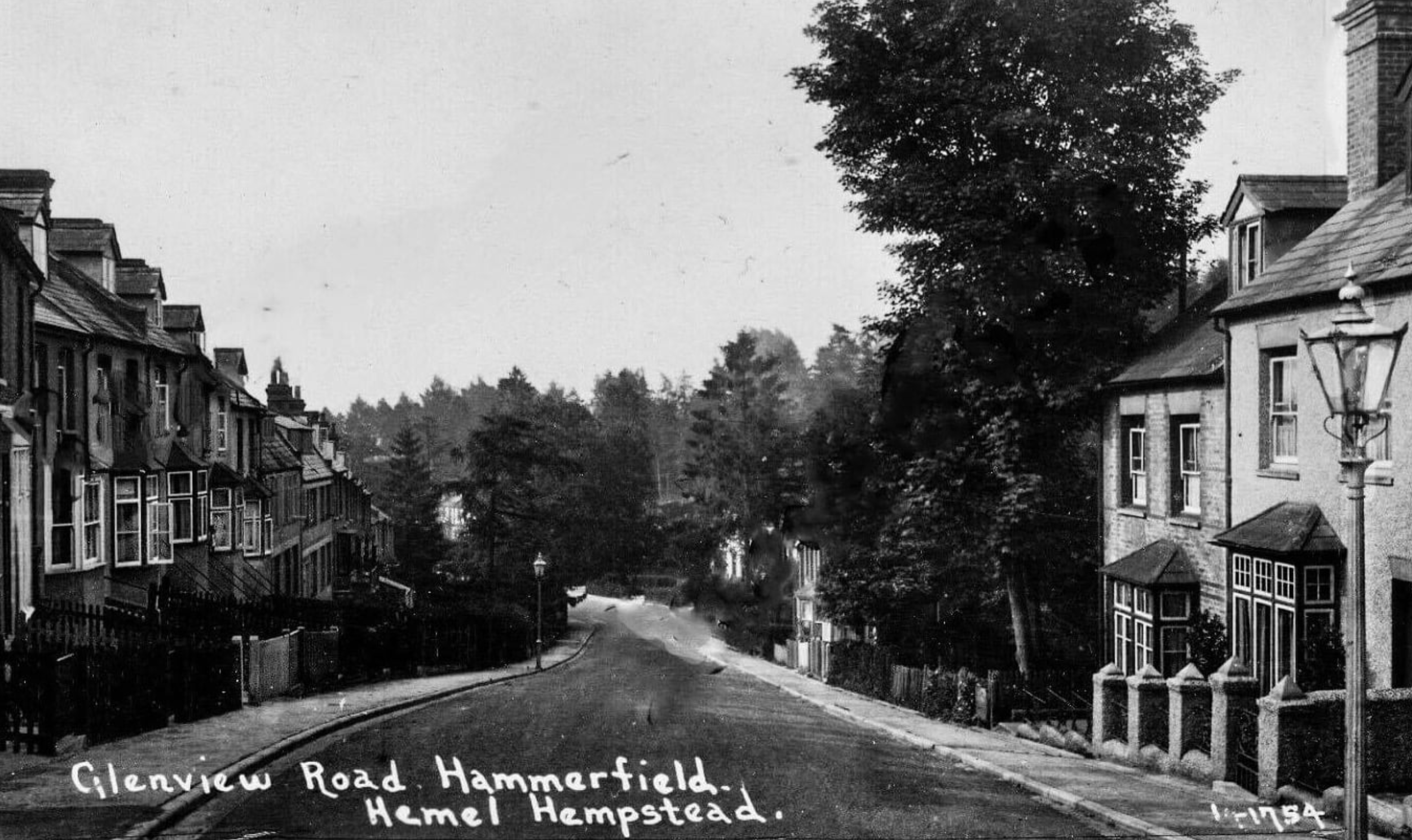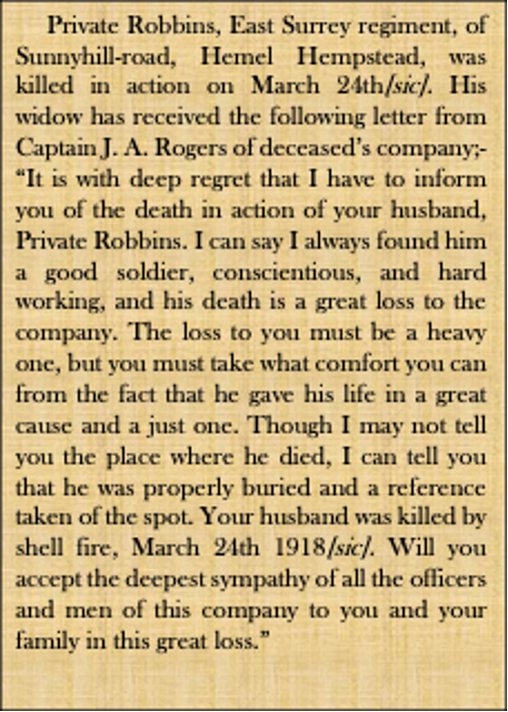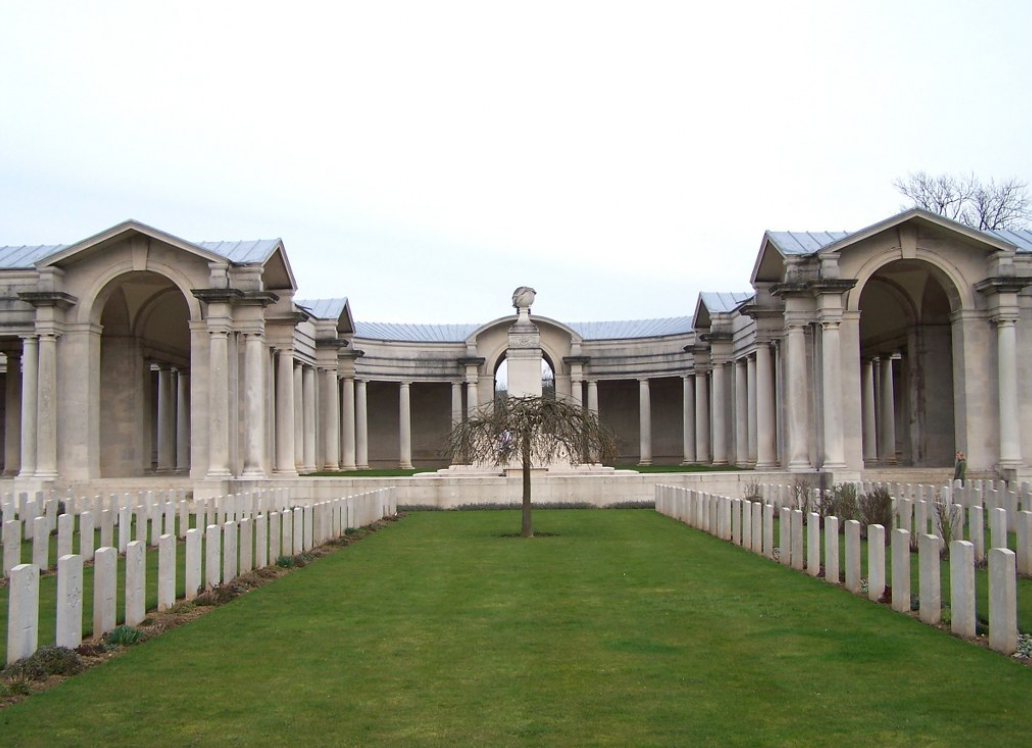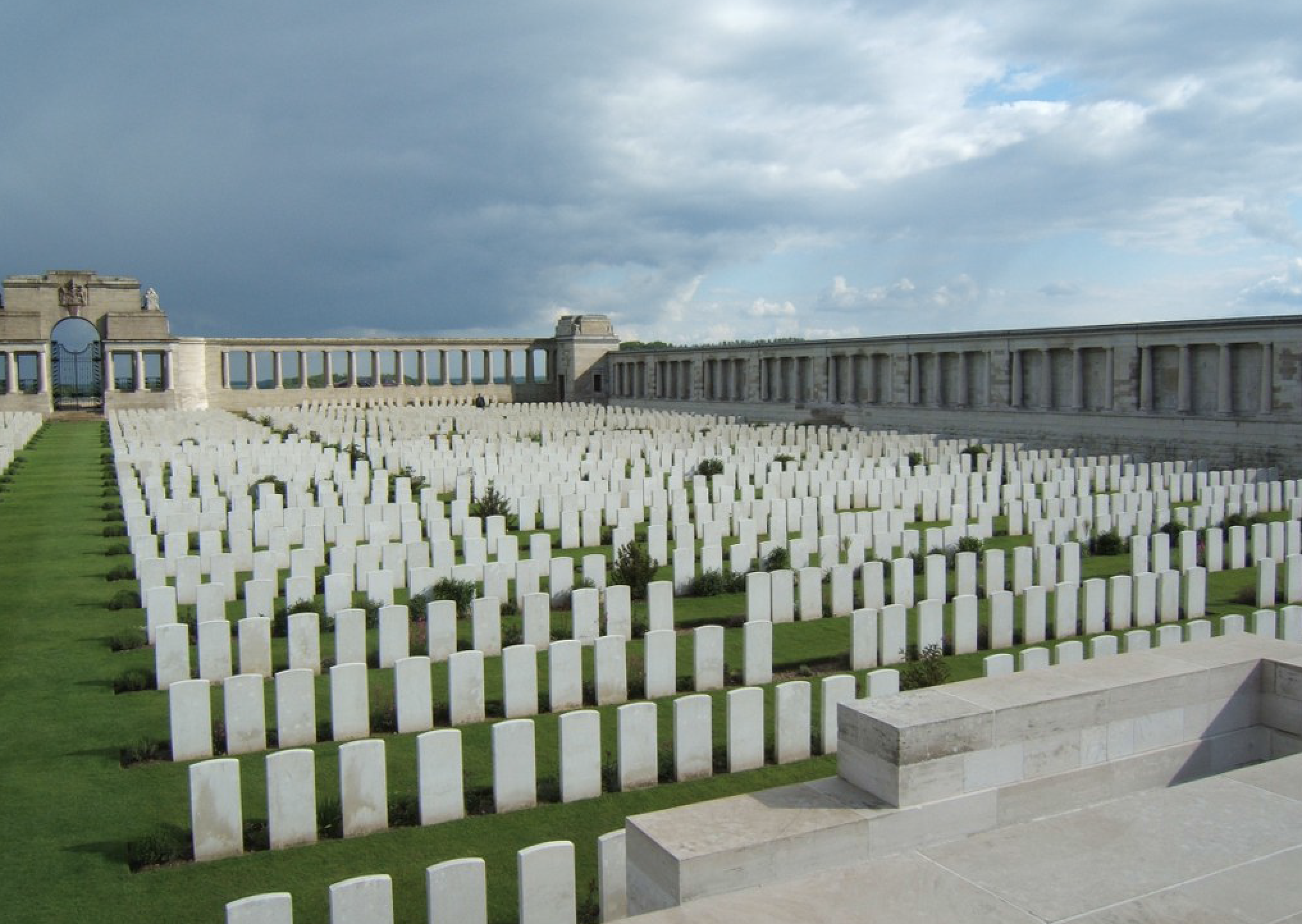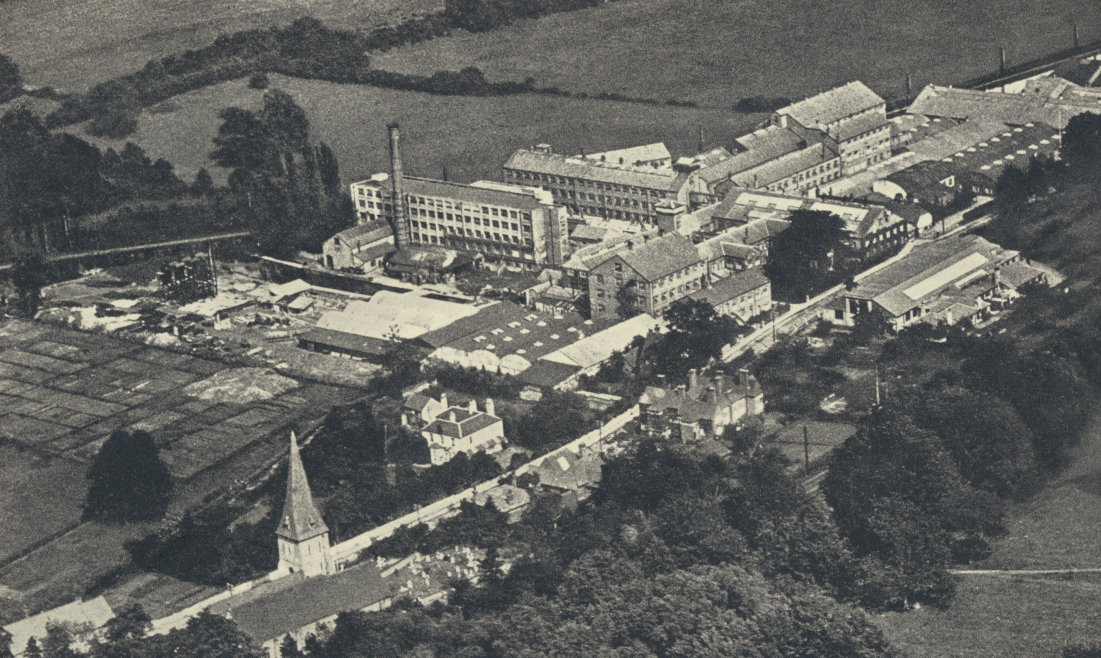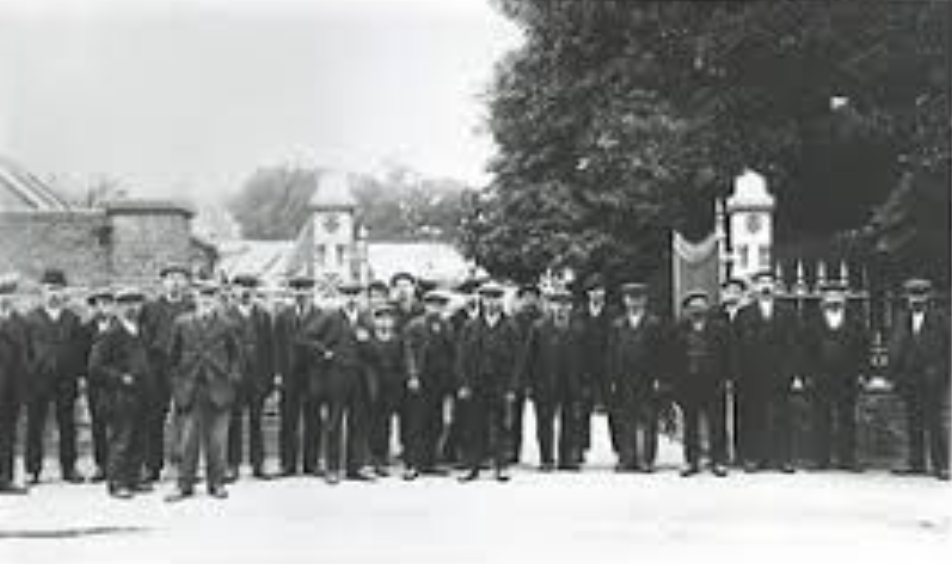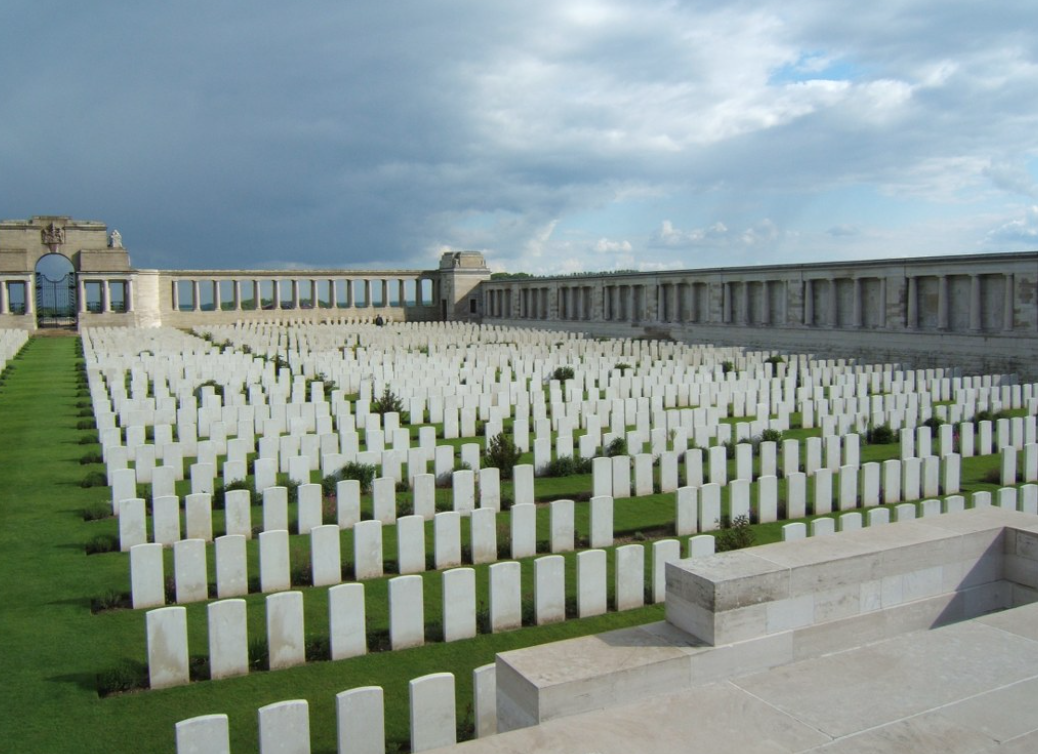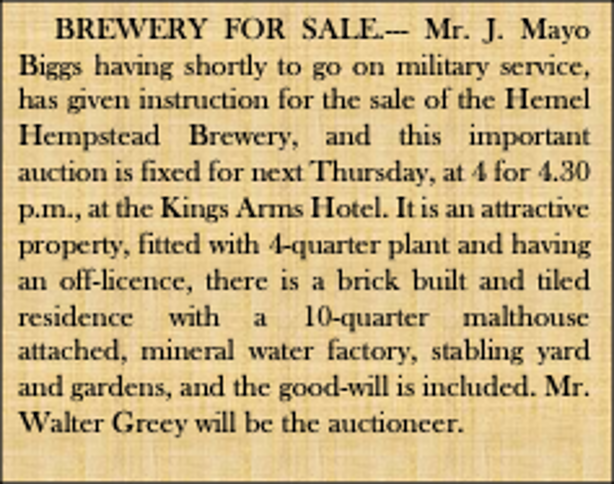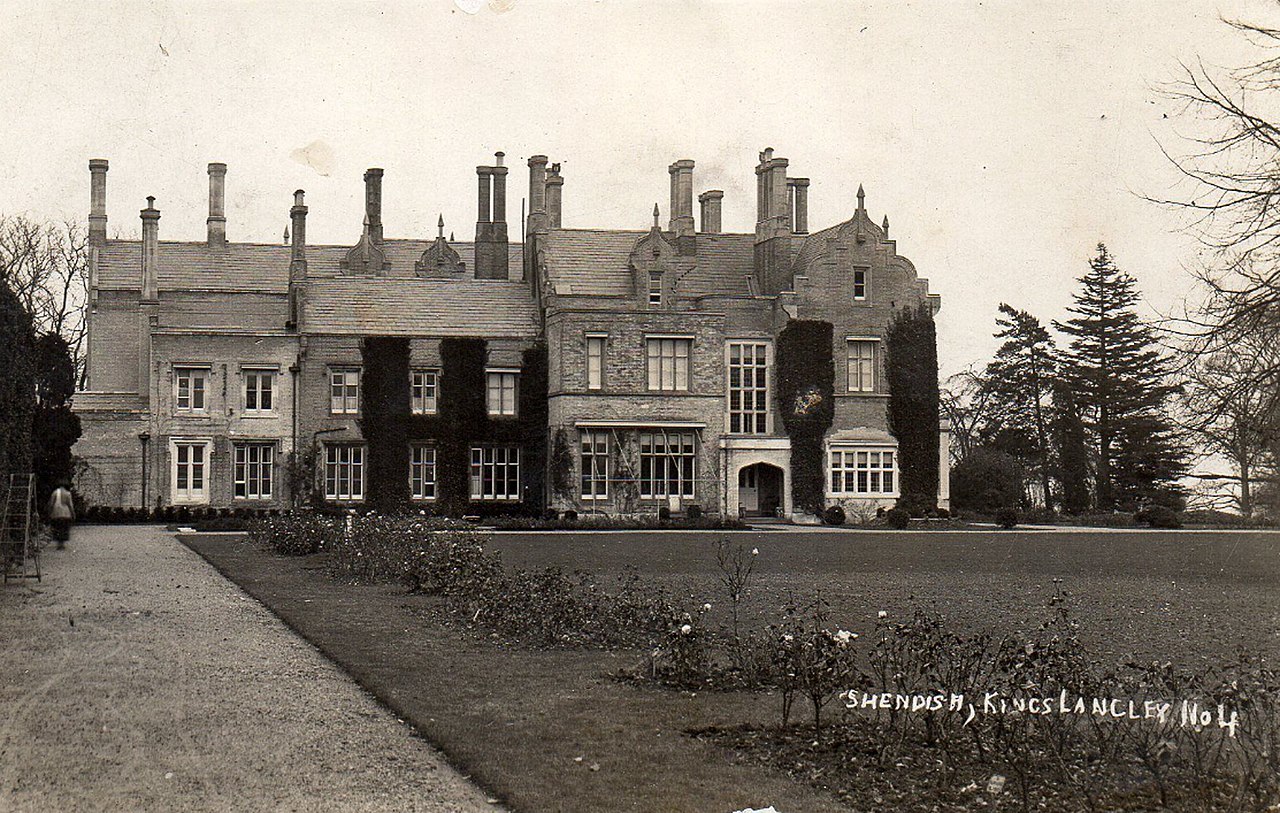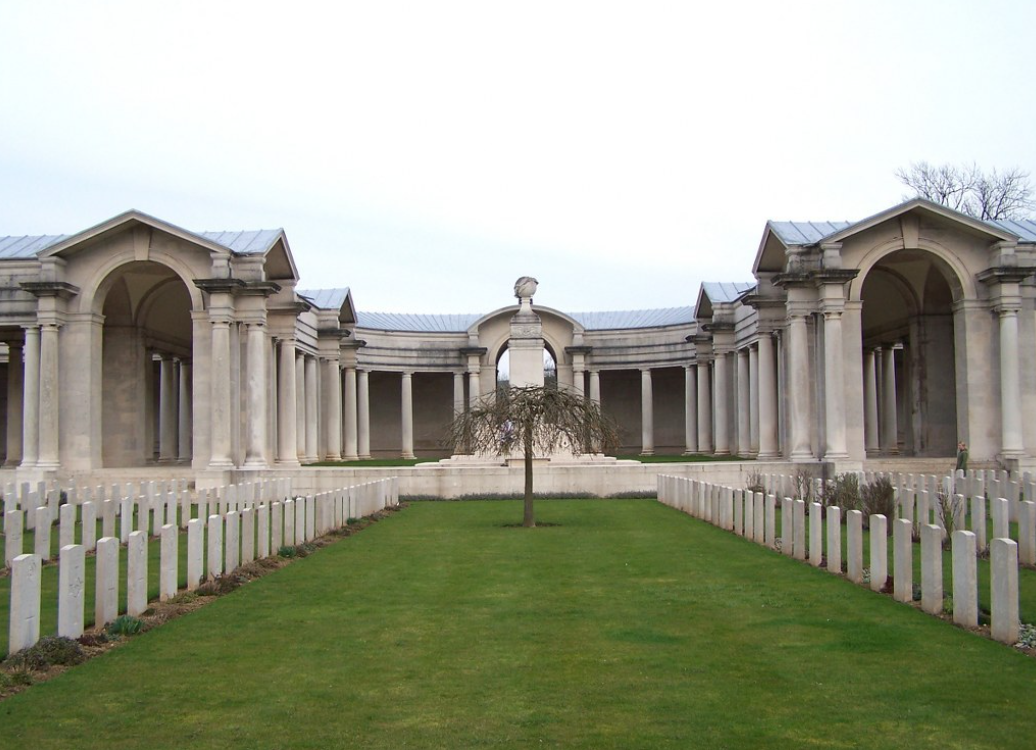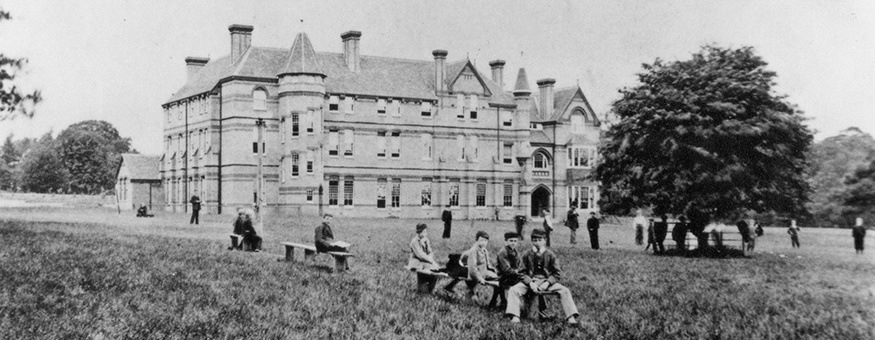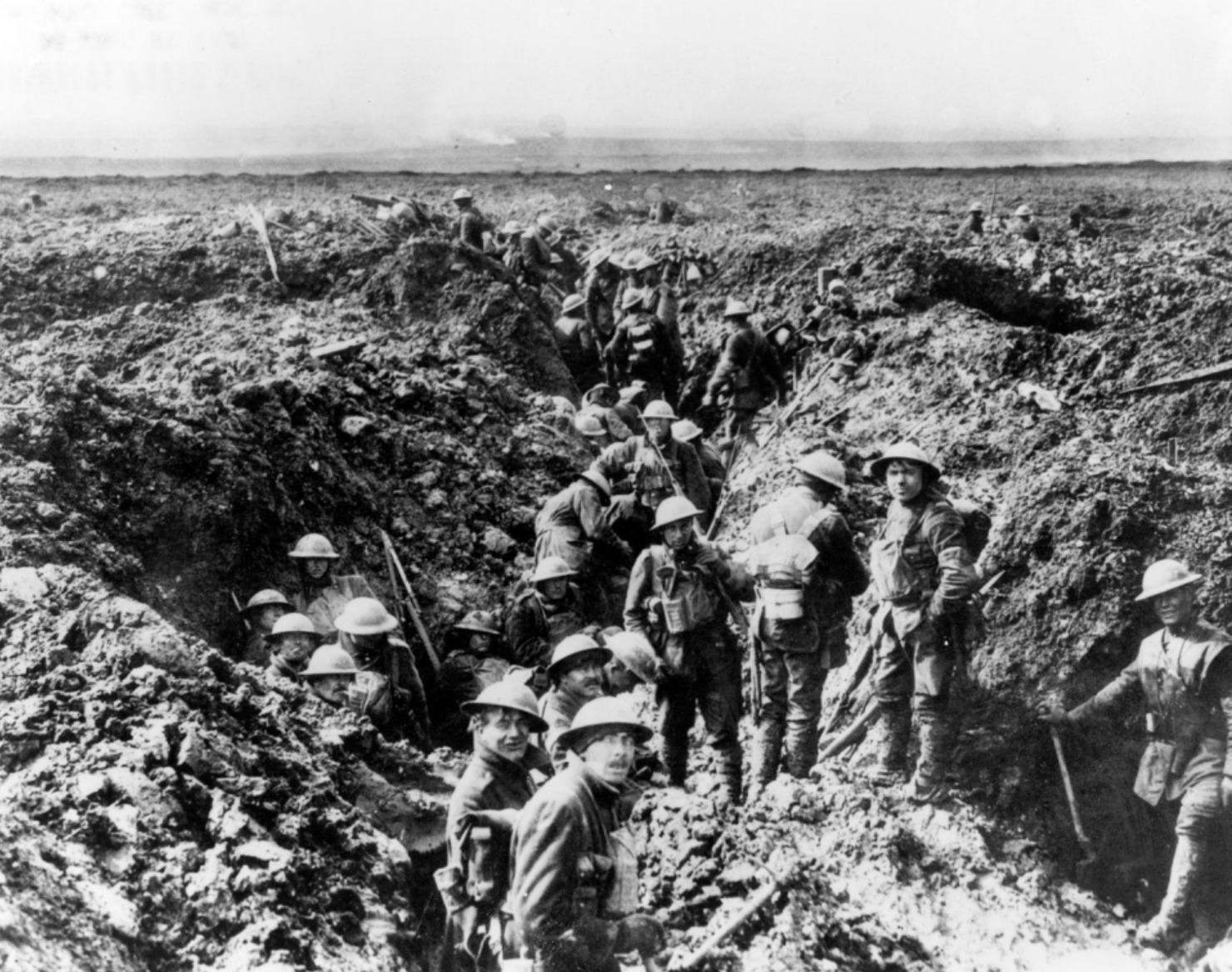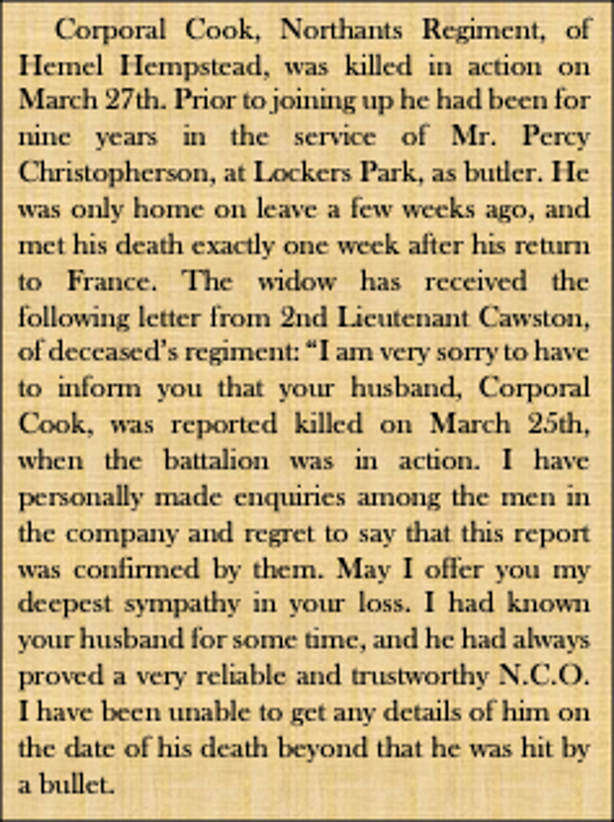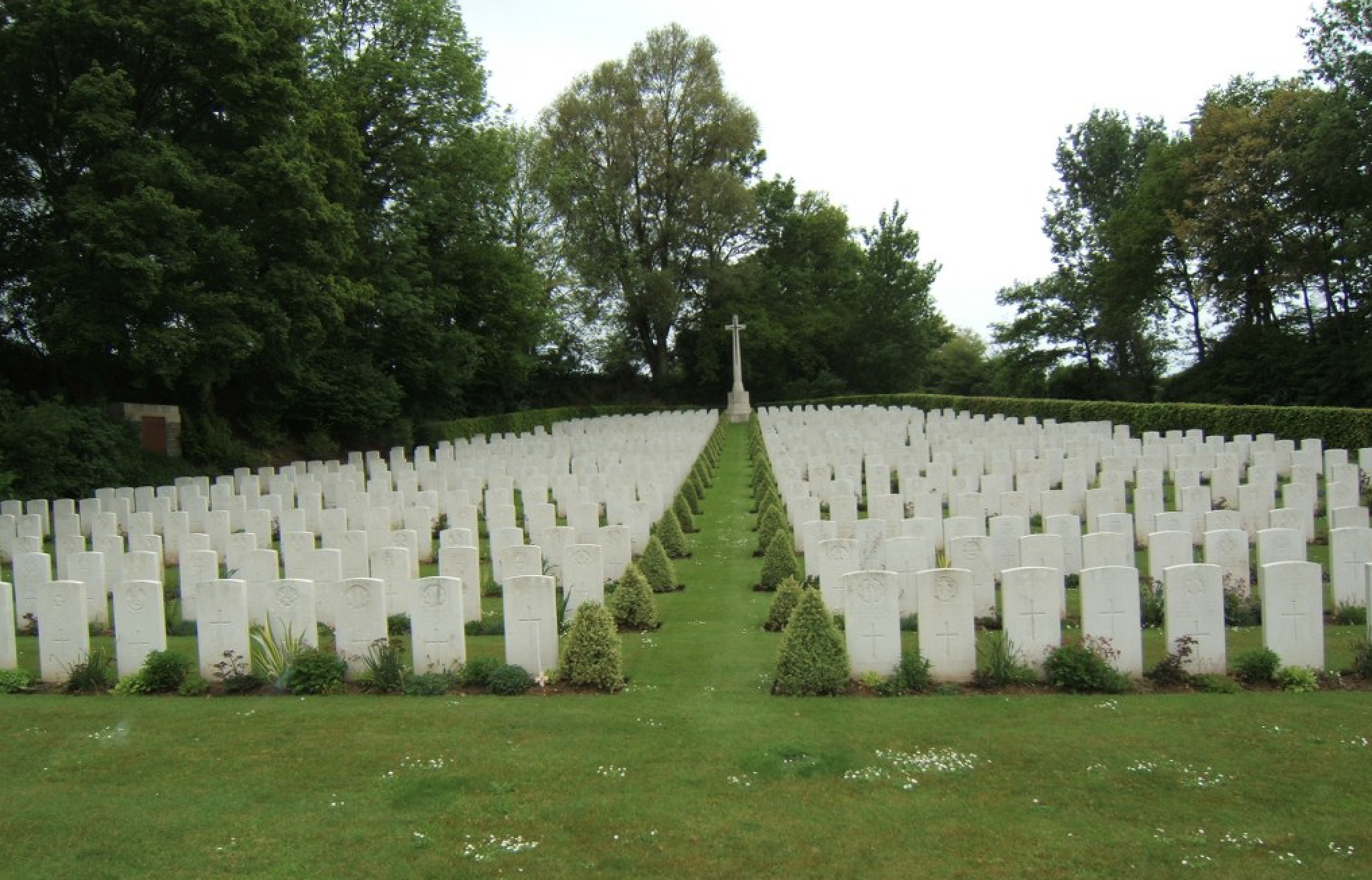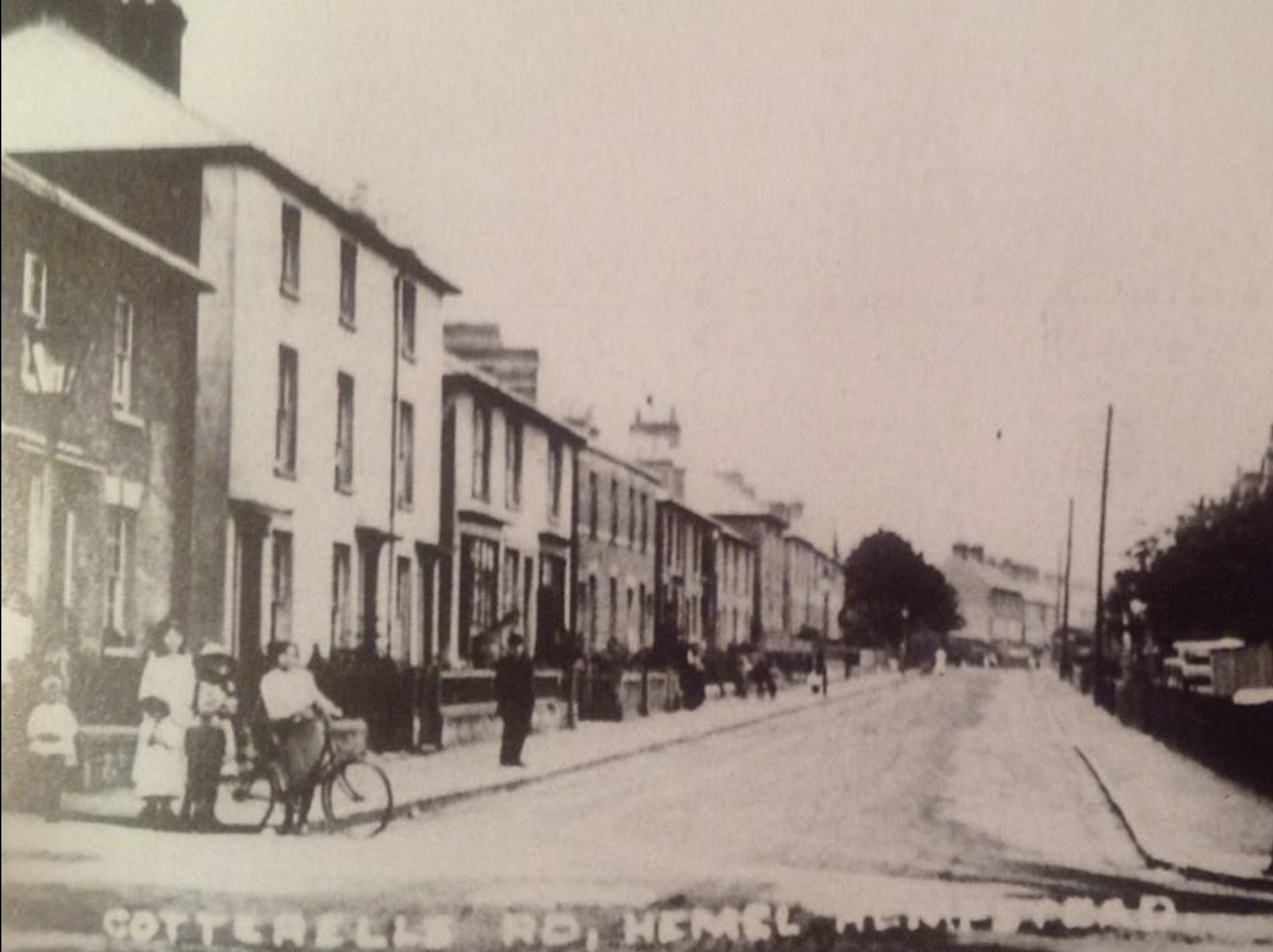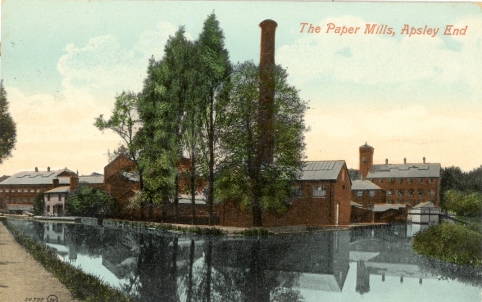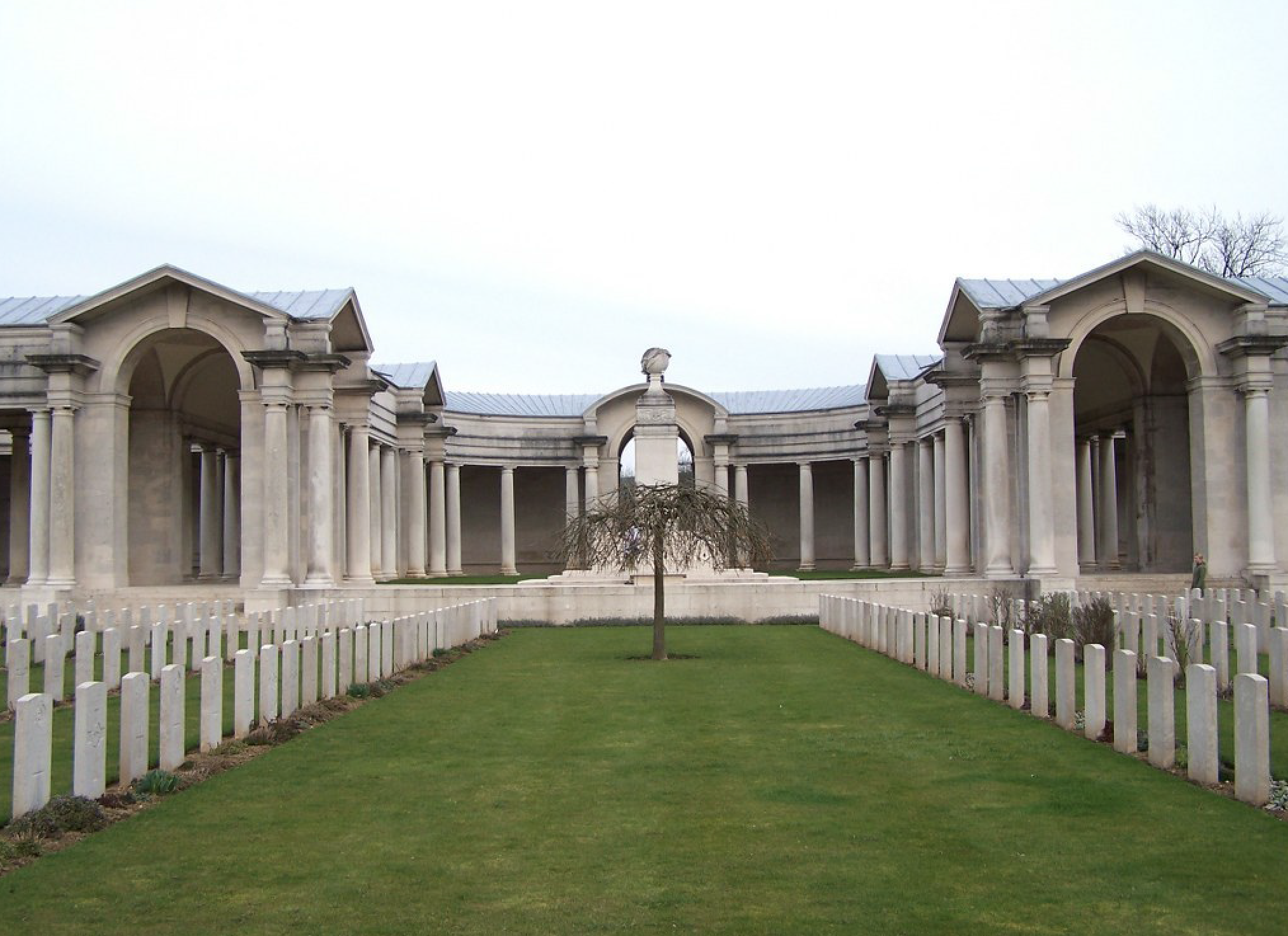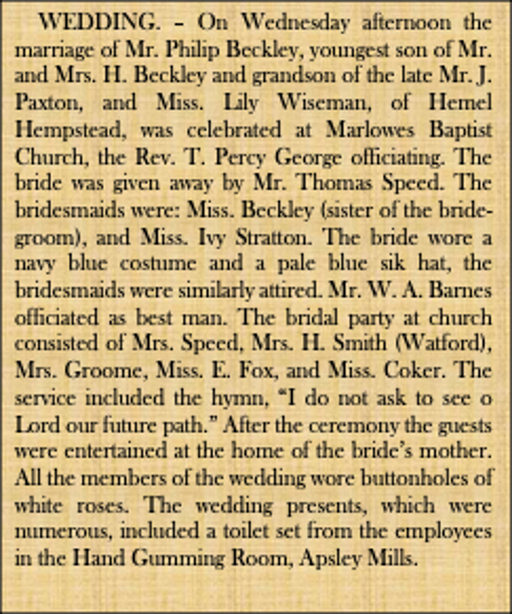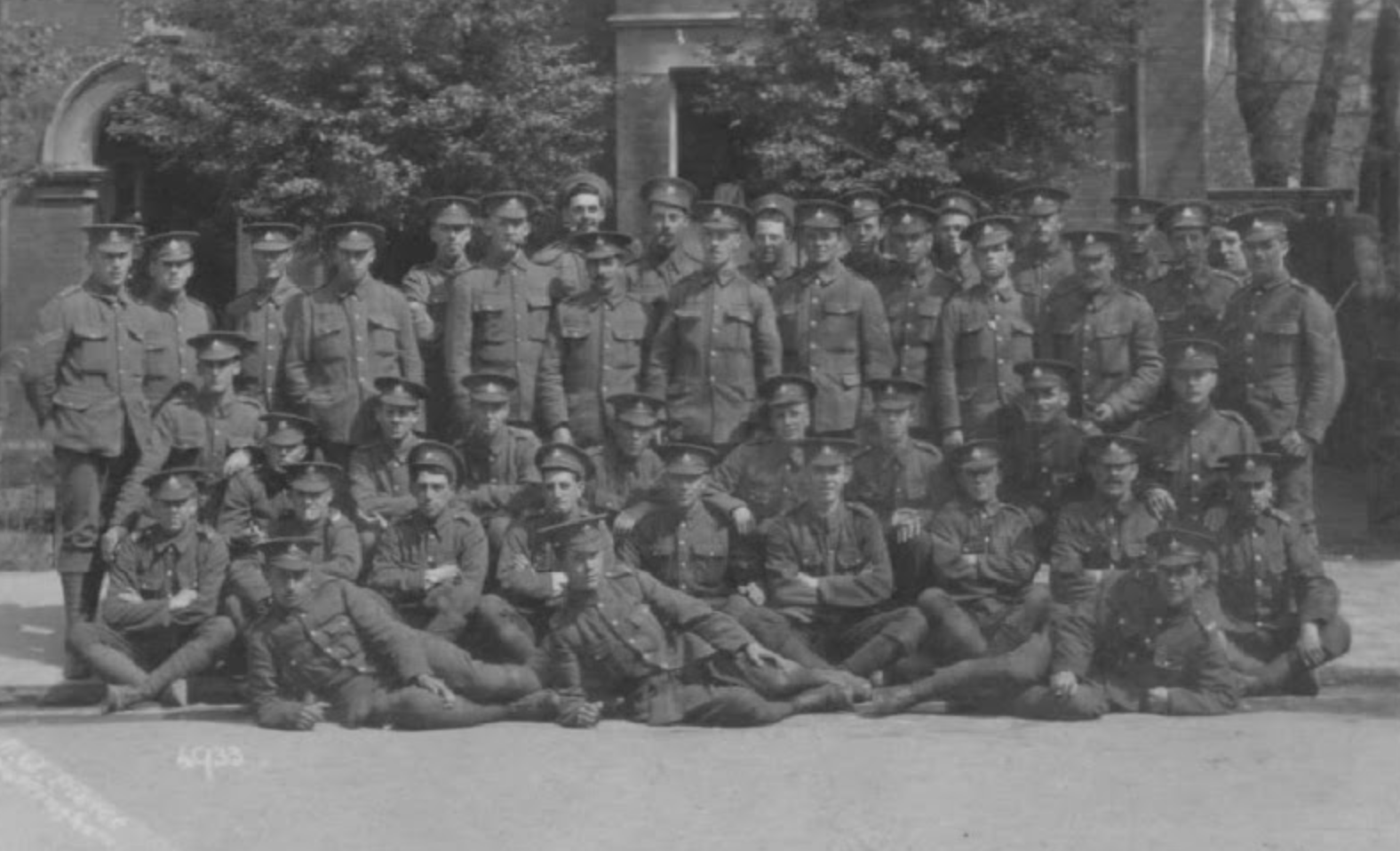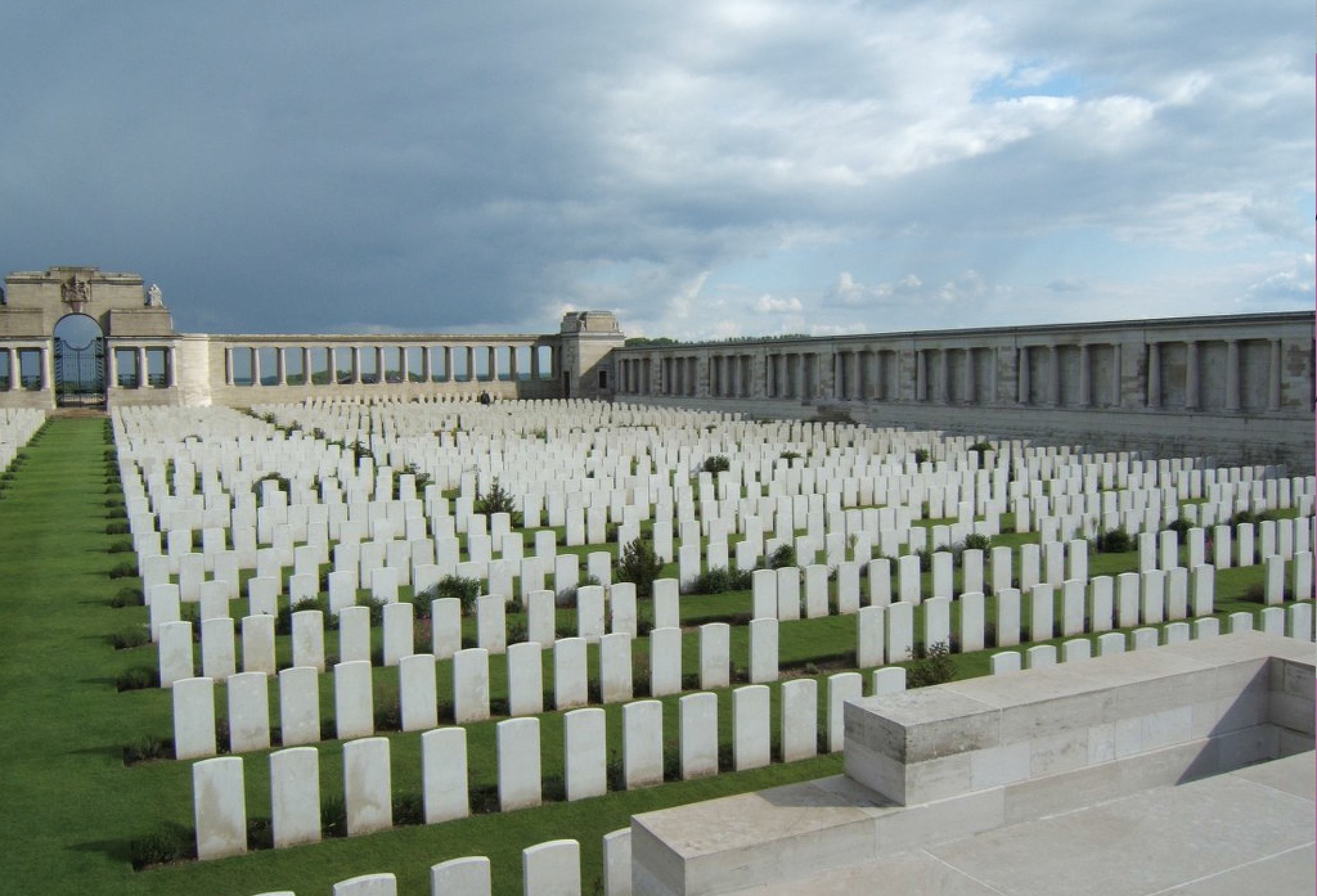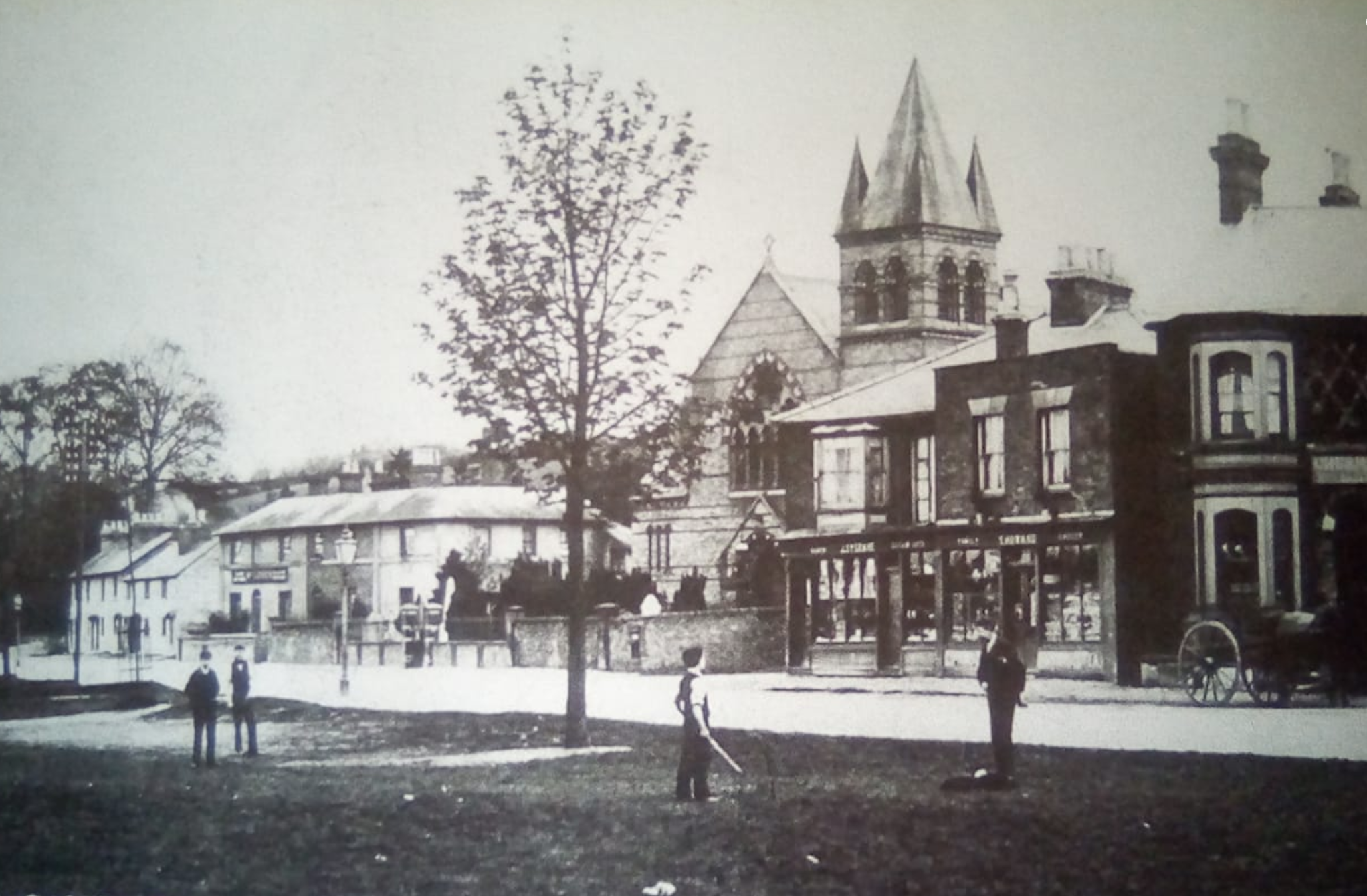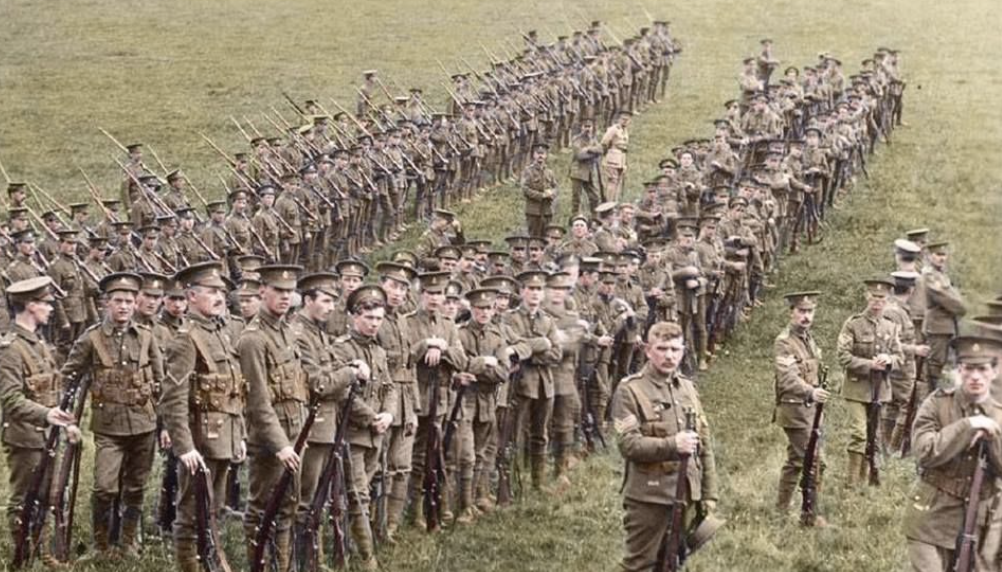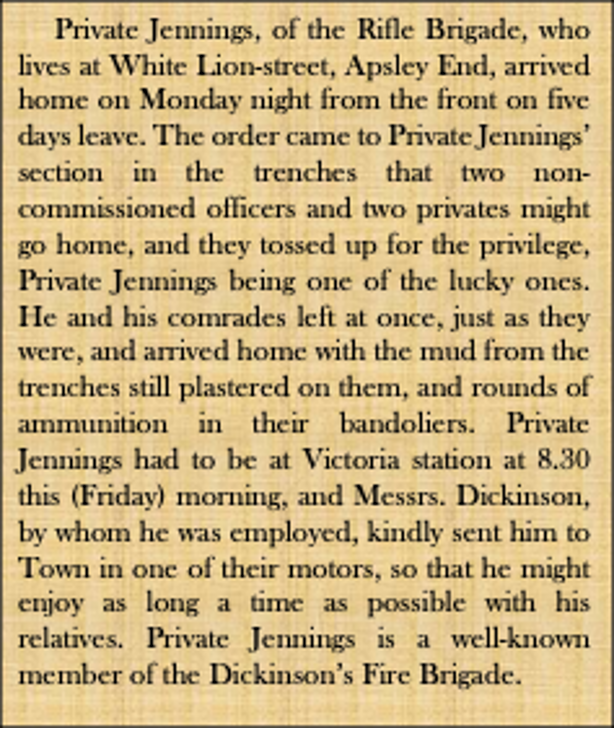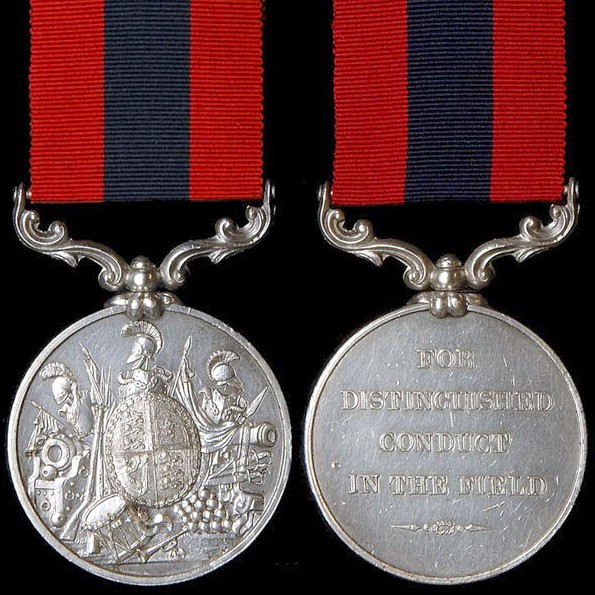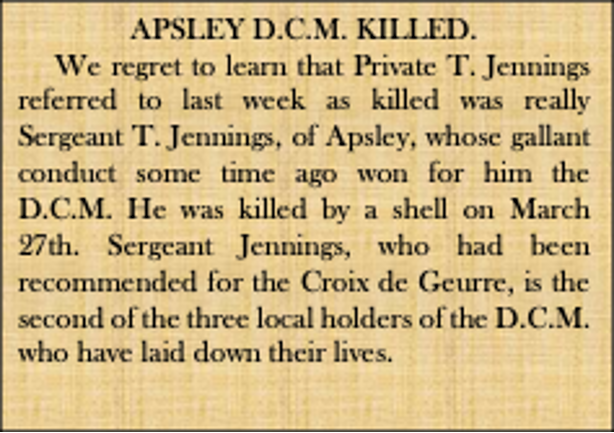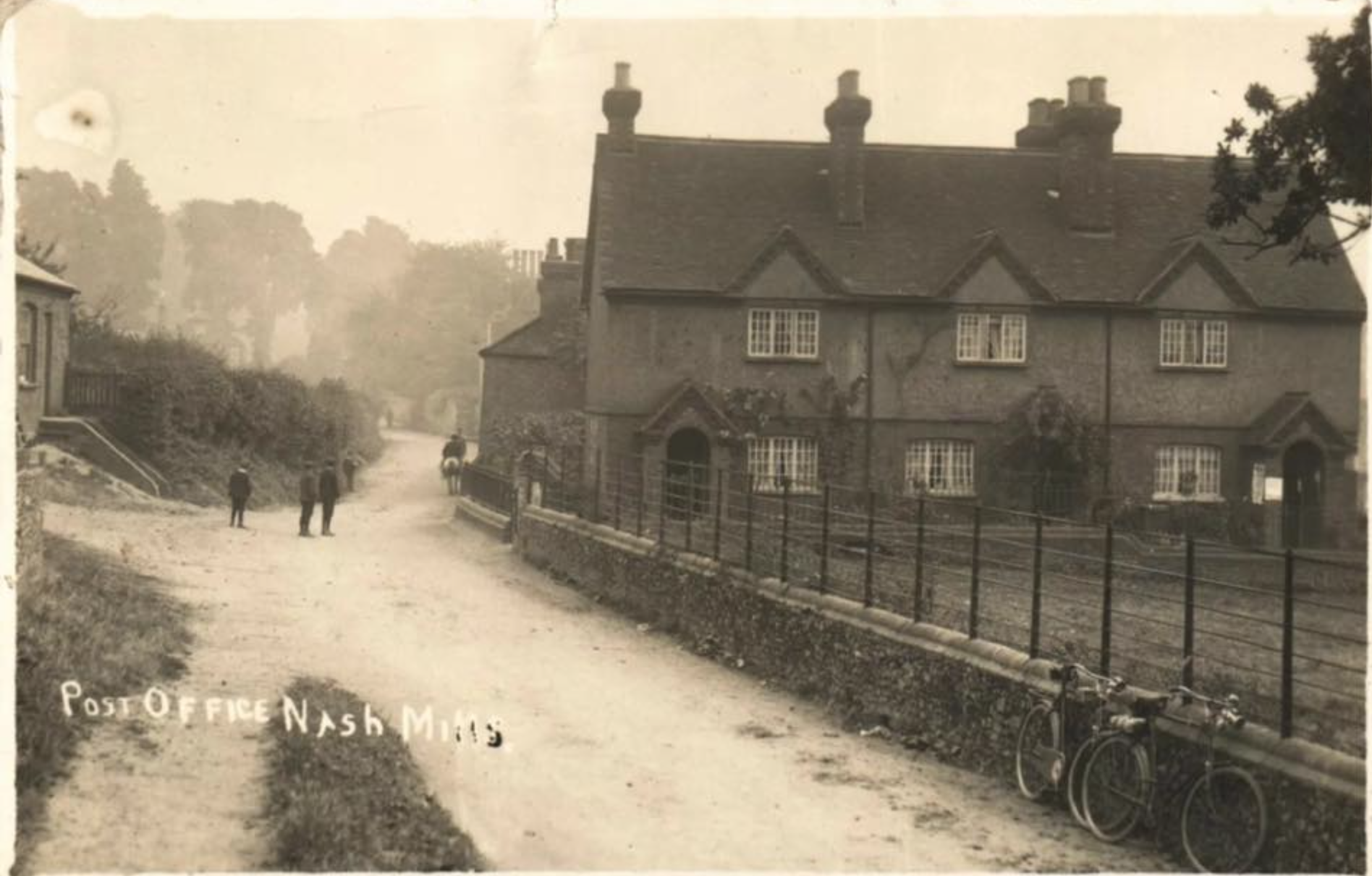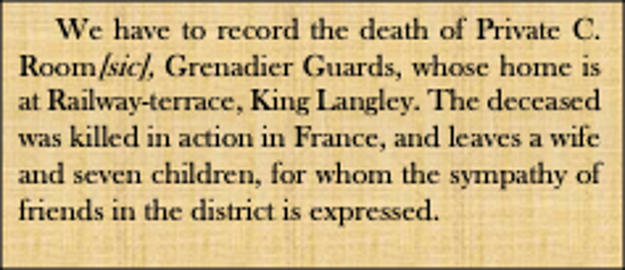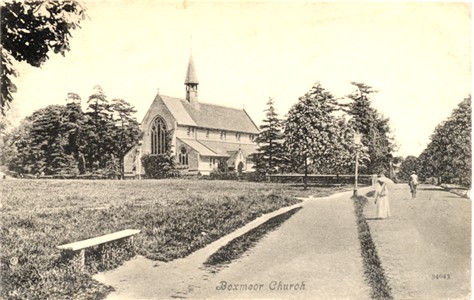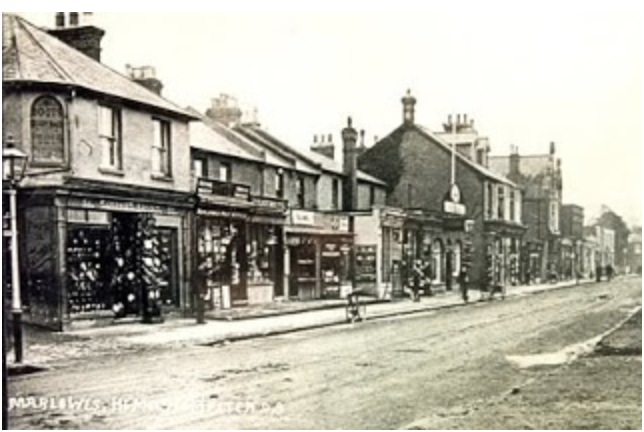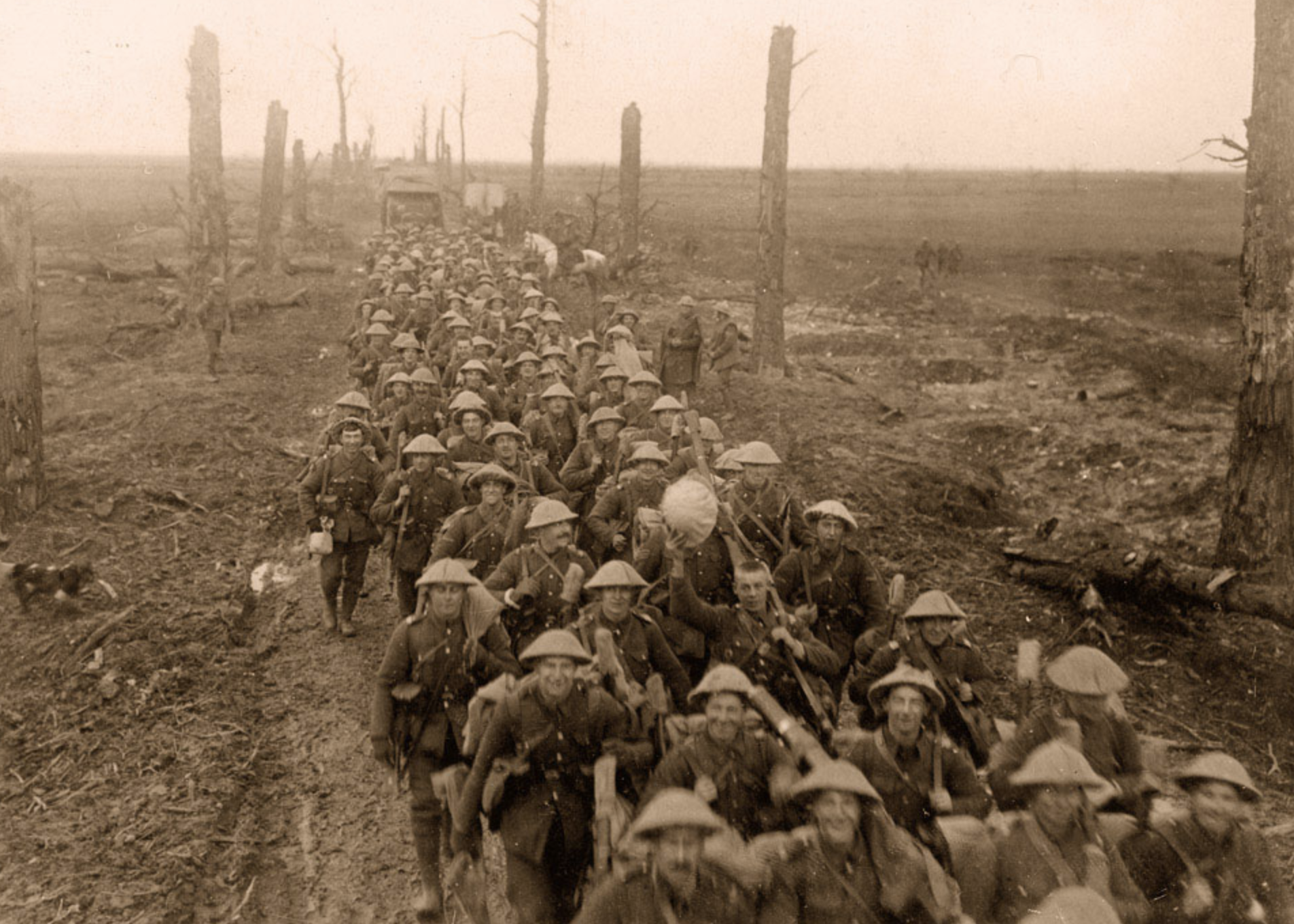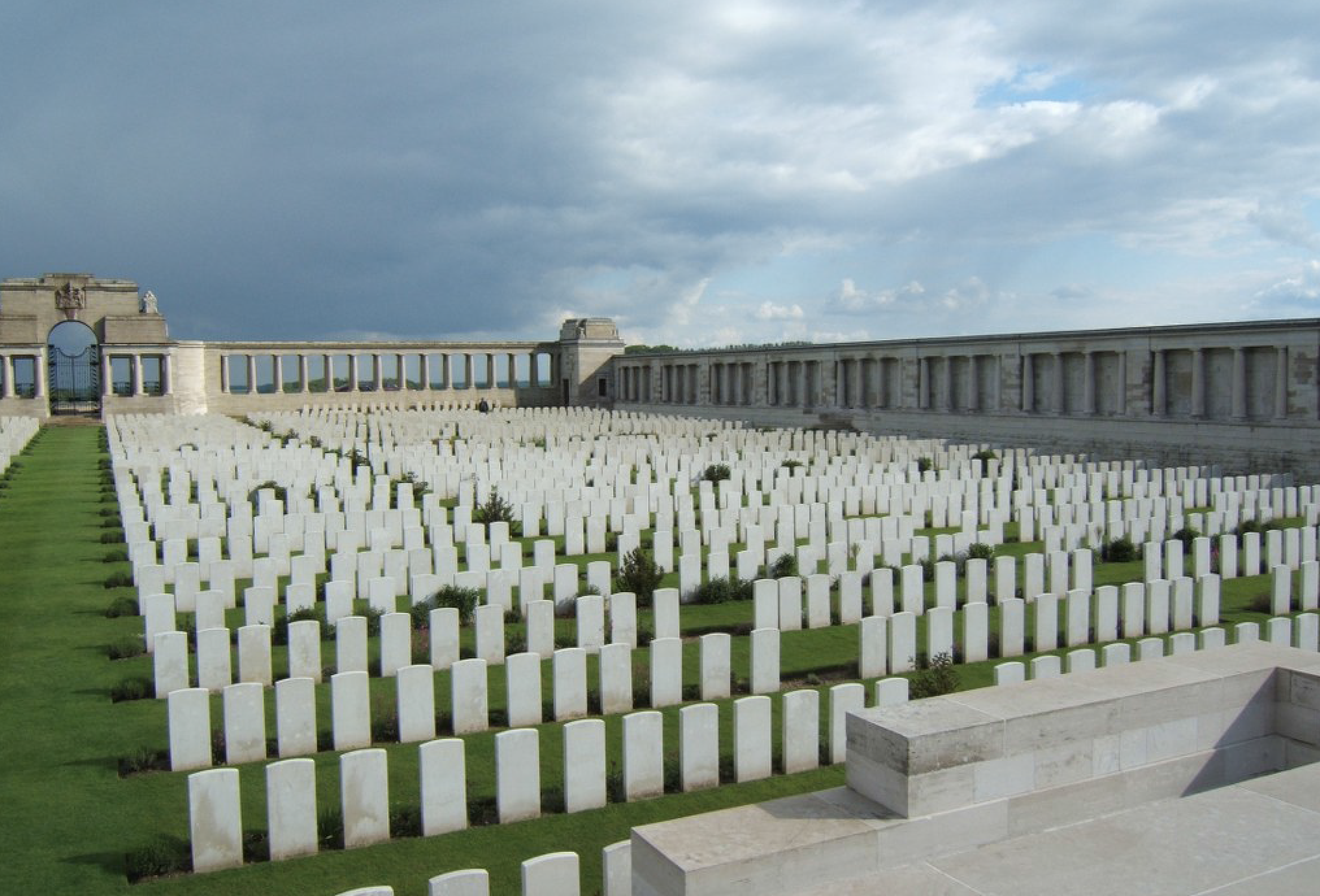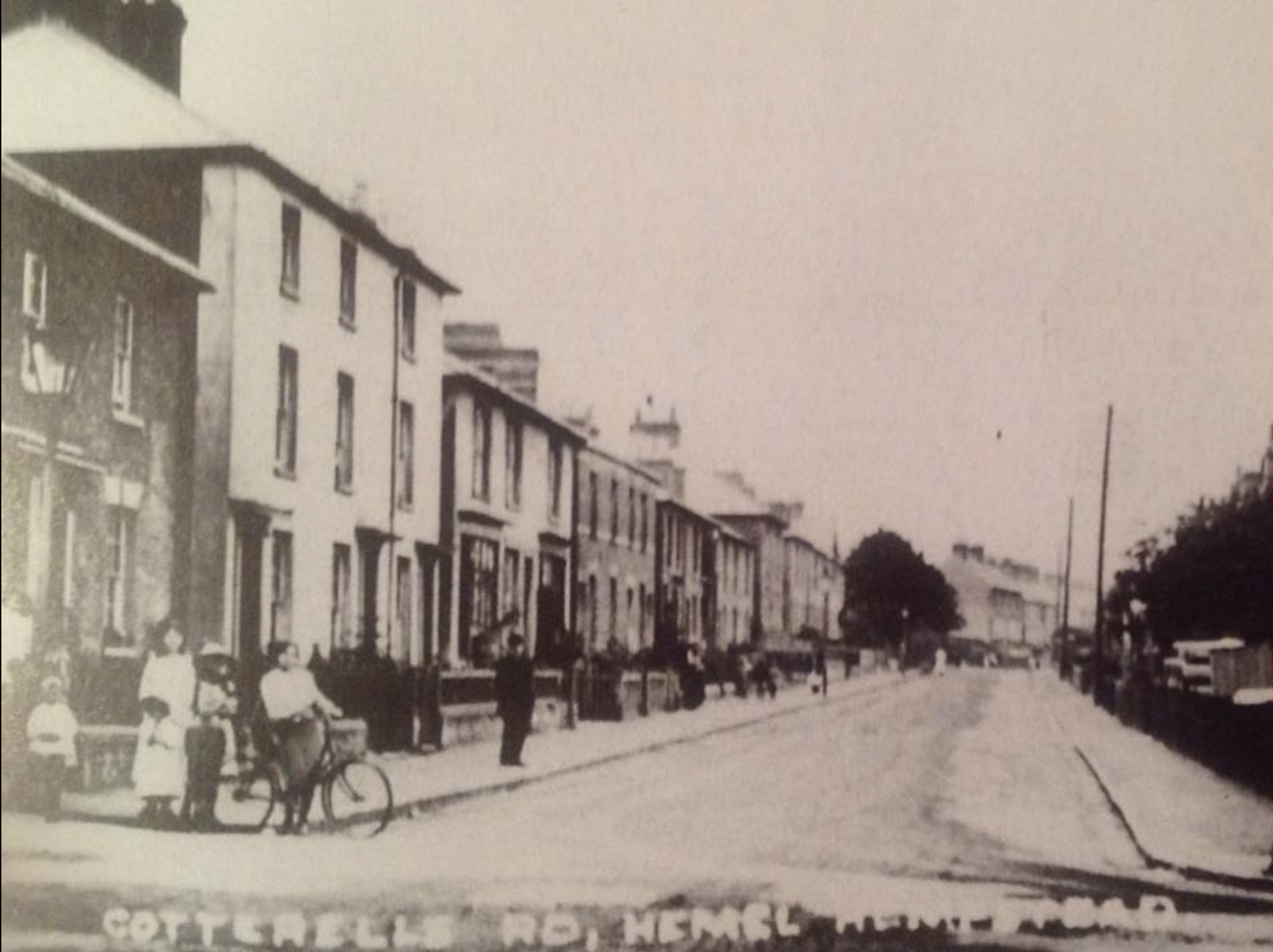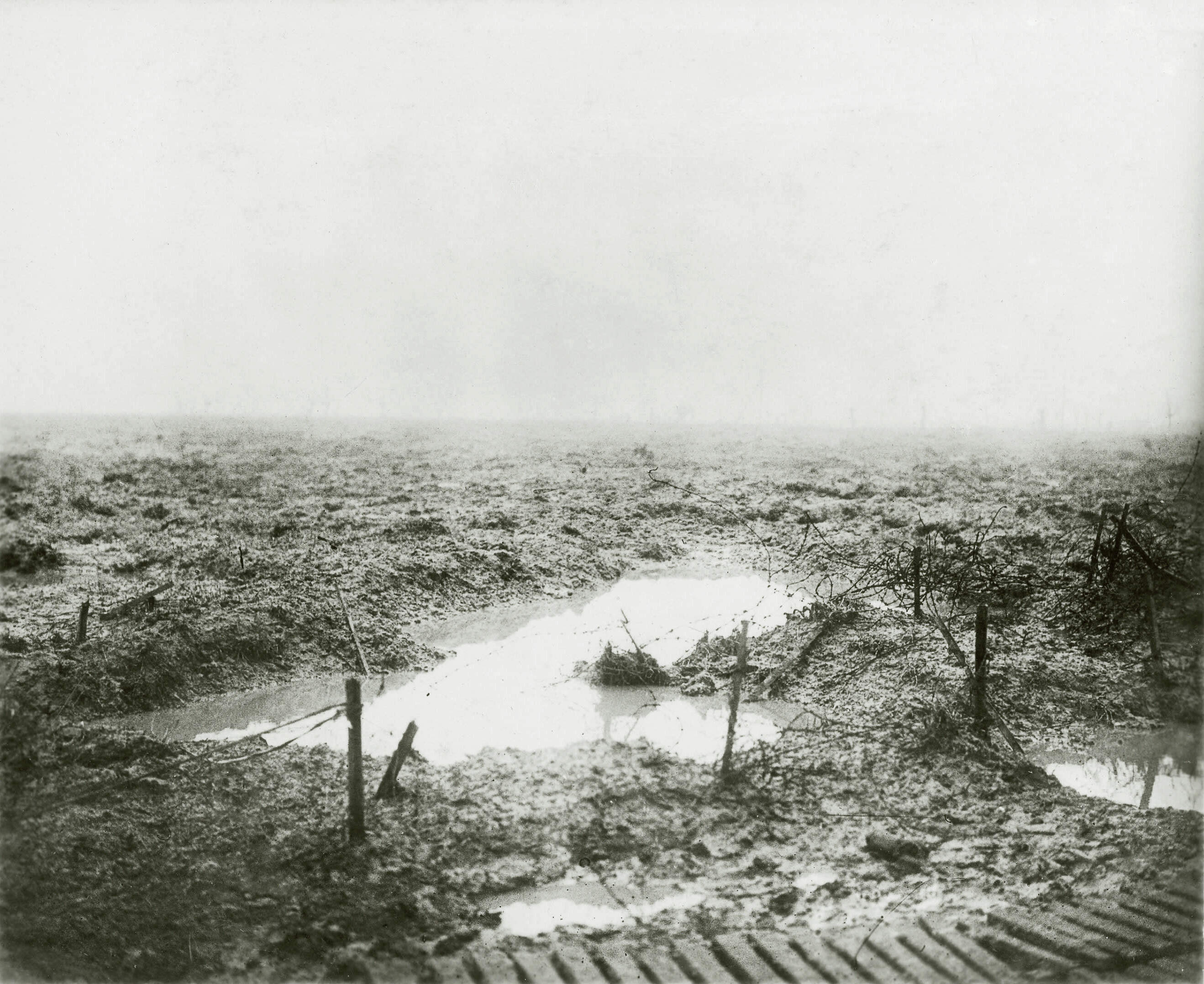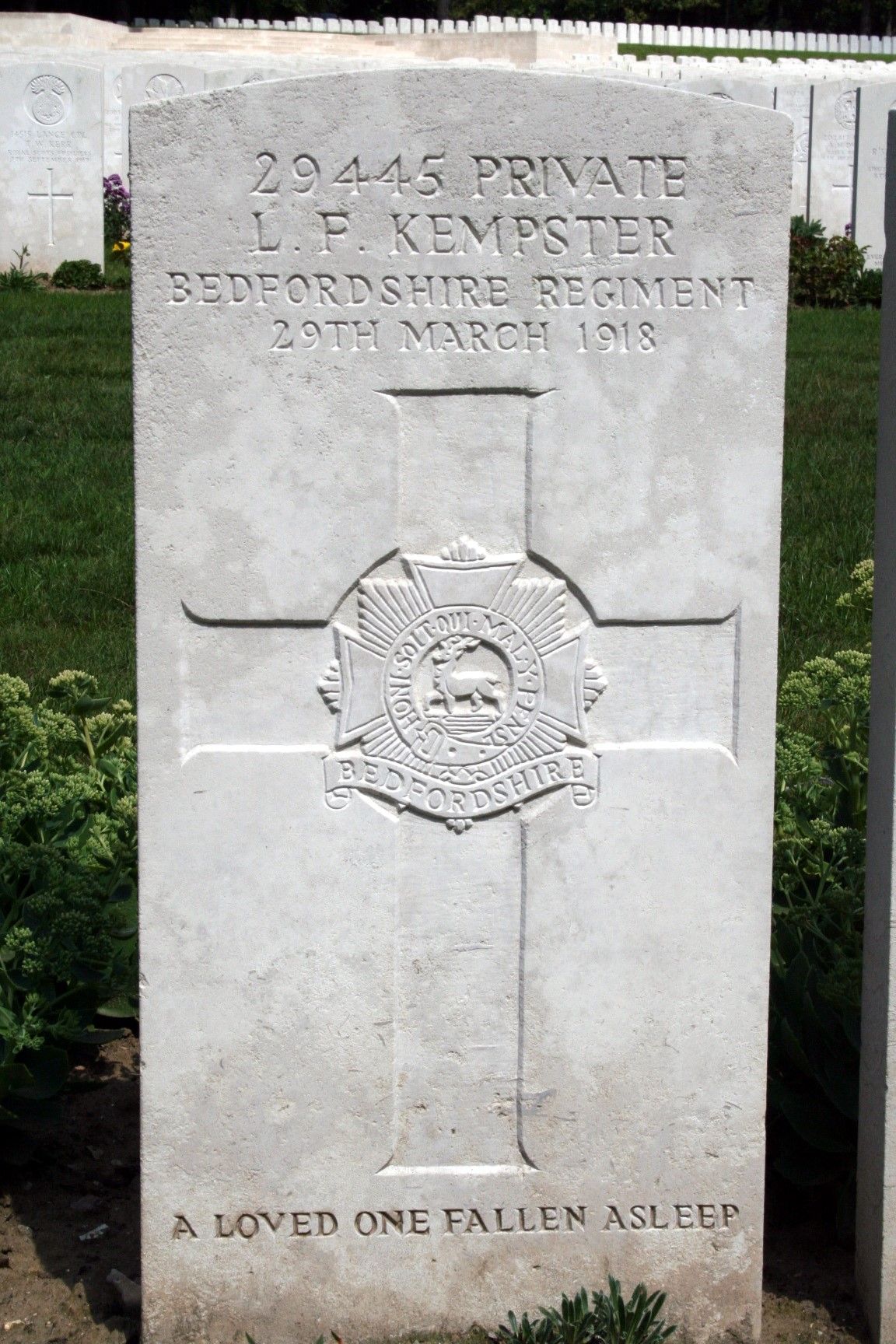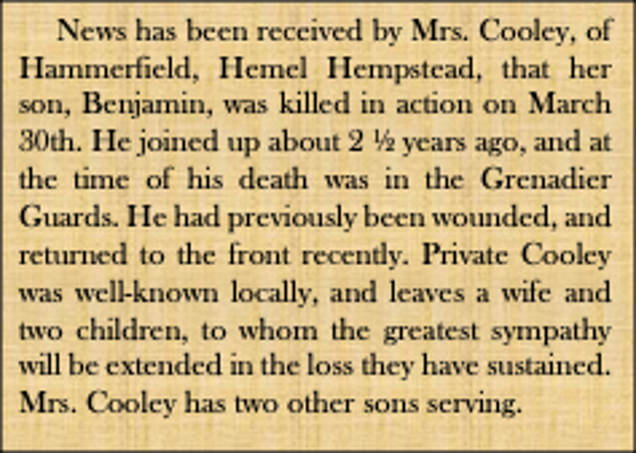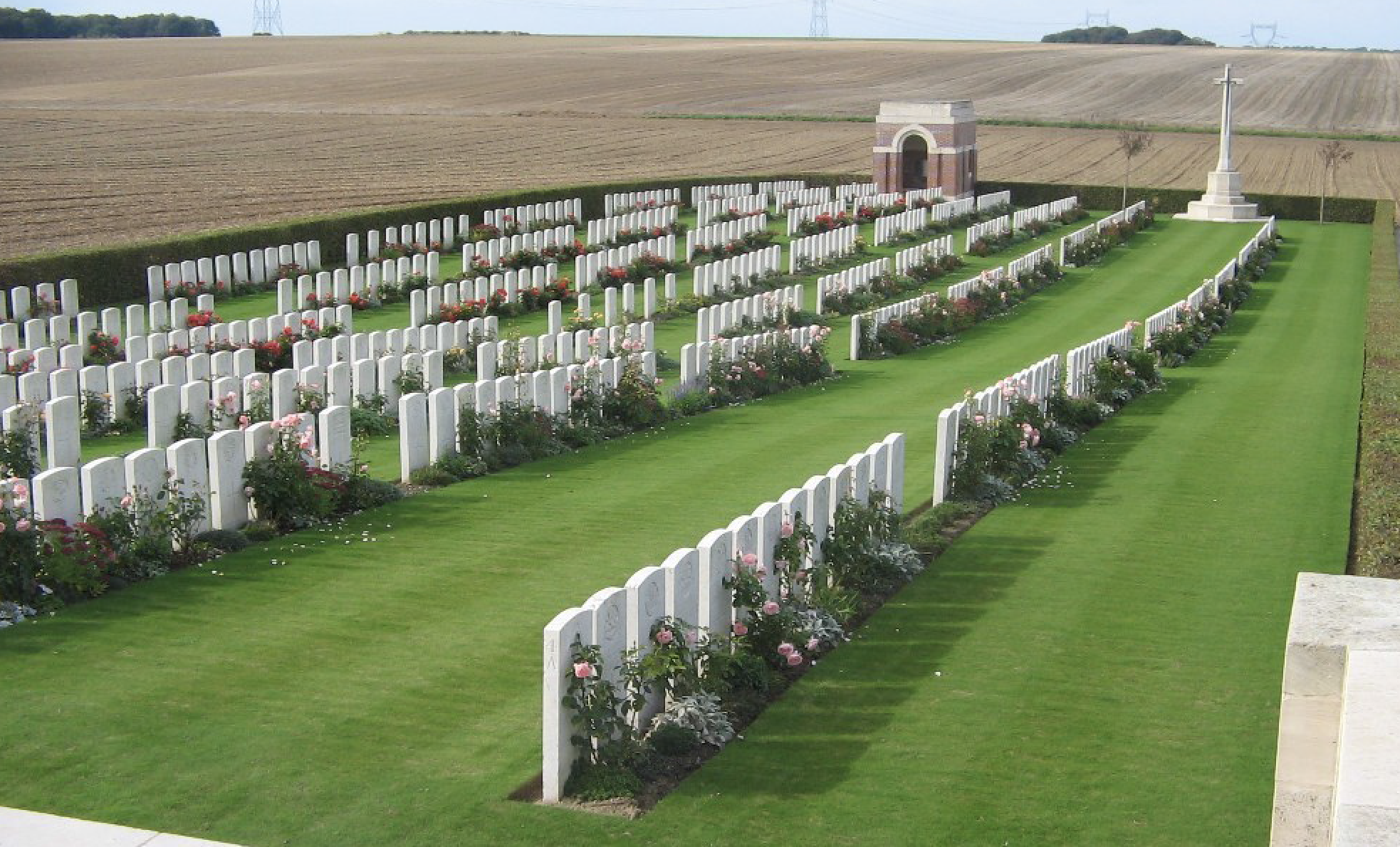Fallen in March 1918:
Victor Perkins
Henry John Moles
William Odell
Thomas Searle
William Robbins
Harry William Freeman M.M.
Alfred Hall
John Mayo Biggs
Robert Cheshire
Arthur Thomas Cook
Alfred Cuthbert Gash
Leonard Wiseman
Thomas Jennings D.C.M.
Ernest William Roome
Charles Alfred Viney
Leonard Frederick Kempster
Benjamin Cooley
VICTOR GEORGE THOMAS PERKINS
23762 Private
7th Bn., Bedfordshire Regiment
Killed in Action Friday, 22nd March 1918
Remembered with Honour, Pozieres Memorial, Somme, France, Panel 28 and 29.
Victor George Thomas Perkins was born in East Sheen, Mortlake, Surrey on Tuesday, 13th April 1897 and baptised at Christ Church a month later on Sunday, 9th May. He was the oldest of four boys born to Tom Perkins and Mary Elizabeth Barnes and his siblings were: Edmund, Arthur and Tom.
Victor’s brother Edmund also enlisted when he was eighteen, but fortunately the War ended before he could go overseas. Tragically, his brother Arthur was killed during the Second World War, as the result of an accident whilst a munitions worker at Brocks firework factory in Hemel Hempstead.
When Victor was born, his father Tom worked as the "Foreman" in a local market garden and the family lived at Orchard Cottage in East Sheen.
In 1904, Victor’s father Tom took on the tenancy of the Three Horseshoes public house in Leverstock Green. His mother Elizabeth ran the attached grocery store and a market garden was established behind the pub.
The family remained at the Three Horseshoes until the 1920’s and Victor’s brother Edmund operated a taxi service to Boxmoor Station, starting around 1919, from the premises. The pub eventually became the village petrol station.
Victor attended the village school in Leverstock Green and was a member of the Boy Scouts. When he left school aged thirteen in 1911, he started work as an apprentice at the "Dairy Outfit Co Ltd", situated at Cornerhall. This company manufactured items such as milk churns, ladles along with other utensils for the dairy industry and known locally as “the old tin can”.
It seems that Victor, like many young men, tried to enlist while underage when war broke out, but he was thwarted because of his poor eyesight (he is wearing glasses in his work photograph to the right).
However, as soon as he was eligible to enlist at eighteen years of age in May 1915, he went to Bedford and enlisted with the Bedfordshire Regiment.
He was sent to train in Felixstowe with the 3rd Battalion and when he was sent overseas, Victor was posted to the 7th (Service) Battalion or “The Shiney Seventh” as it was popularly known. It is not known exactly when he went overseas, but it would have been after basic training and when he had reached the age of nineteen, so some time after April 1916. He probably arrived at Picquigny in France as part of a draft in mid-June, as preparations were underway for the Somme Offensive.
The 7th Battalion was heavily engaged during The Battles of the Somme, specifically at the Battle of Albert which included, the storming of Pommiers Redoubt on the first day of the attack. This was followed by the Battle of Bazentin, when the Division captured Trones Wood in July and then the Battle of Thiepval in September.
In 1917, Victor was involved during the Operations on the Ancre, including the Actions of Miraumont in February and the Capture or Irles in March. In May he fought in the Battle of Arras, namely at the Third Battle of the Scarpe.
The “Shiney Seventh” then moved to Belgium and Victor fought in the Third Battle of Ypres, specifically the Capture of Westhoek in August and then the First Battle of Passchendaele in October.
Having survived these encounters, Victor moved back to France with his unit in February 1918 for a period of rest, relief and training around the Remigny area. On the 21st March he fought in the Battle of St Quentin, the opening phase of the Second Battle of the Somme.
Four days of intense fighting followed with heavy bombardment and machine gun fire resulting in significant casualties. The Battalion War Diaries recorded the following on the 26th March: “O.R. Killed 22 Wounded 140 Wounded & Missing 4 Missing 99”
It is not clear if Victor was Killed in Action or Died of Wounds, indeed his "Register of Effects" state it could have been either. What is certain though is that he fell during this battle.
Victor died on Friday, 22nd March 1918.
He was commemorated on his parent’s headstone in Holy Trinity Churchyard as well as the Leverstock Green village War Memorial.
Victor is Remembered with Honour on Pozieres Memorial, Somme, France, Panel 28 and 29.
He was only 20 years old when he died.
Victor was eligible for the British War Medal and the Allied Victory Medal.
Pte. Victor Perkins c1915 (Photo: Peter Green and Mary Cole)
Three Horseshoes with Victor’s parents and brothers Edmund and Arthur (Photo: Leverstock Green Chronicle)
Dairy Outfit Co. Limited – Victor is 2nd apprentice from left, front row (Courtesy: Peter Green and Mary Cole)
Leverstock Green War Memorial Plaque (Photo: Traquair Photography)
Pozieres Memorial, Somme, France (Photo: CWGC)
HENRY JOHN MOLES
41415 Corporal
2nd/5th Bn., Lincolnshire Regiment
Died of Wounds Saturday, 23rd March 1918
Remembered with Honour, Queant Road Cemetery, Buissy, Pas de Calais, France, Noreuil German Cem. Mem. 3.
Henry John Moles was born in Hitchin, Hertfordshire on Monday, 2nd May 1898 and baptised on Wednesday, 11th January 1899 at St Agnes Church, Kennington, Southwark. He was the second child born to John William Moles and Susan Brownsmith, who had five children together who were: Edith Ellen, Henry John, Leonard William, Sidney James and Mary Margaret.
St Agnes Church where he was baptised was originally designed by the architect Gilbert Scott and it was sadly destroyed by enemy bombing in the Second World War.
Henry’s younger brother Leonard also fought in the Great War and survived the conflict. Leonard followed his father into the Hertfordshire Constabulary and like his father attained the rank of Sergeant.
Henry’s father John had been a "Baker", but joined the Police Force shortly after marrying in 1896. John was posted to Hitchin with the Hertfordshire Constabulary and was living at the Police House there in 1901. Ten years later he had been promoted to Sergeant had moved to Ware, Hertfordshire. By the time of his retirement, he had attained the rank of Superintendent and closed out his police service at Hoddesdon, Hertfordshire.
On the outbreak of war Henry was amongst the first volunteers and he went to Hertford where he attested in August 1914, enlisting with the Duke of Wellington’s West Riding Regiment. His choice of regiment may have been influenced by his father who hailed from North Yorkshire, or it may have been a way of ensuring no-one would know him in his new regiment.
The reason for this is simple, he was sixteen years and three months old when he attested, so clearly falsified his age. He was probably tall and physically well developed for his age, and it may have been the case that the Recruiting Officer turned a blind eye.
Hundreds of thousands of underage volunteers tried to enlist and some 250,000 succeeded. Official government policy was that you had to be eighteen to sign up and nineteen to fight overseas.
In the early twentieth century most people didn’t have birth certificates, so it was easy to lie about your age. It didn’t help that recruitment officers were paid two shillings and sixpence (about £6 in today’s money) for each new recruit, and would often turn a blind eye to any concern they had about age. At the same time, though, some officers thought the fresh air and good food of the army would do some of the more under-nourished boys a bit of good.
The recruitment process included medical checks, to make sure a potential recruit was fit enough to fight rather than if he was old enough. The minimum height requirement was five feet, three inches, with a minimum chest size of thirty four inches, so a strapping sixteen year-old was very likely to be let through.
The rule of thumb seemed to be if the volunteer wanted to fight for his country and was physically fit enough to do so, why stop him? But it wasn’t just in recruitment offices. The whole of society seemed to be complicit in sending these boys abroad to fight.
Parents, headmasters, even MPs helped get underage lads into the army. There was collusion on all sides to get these boys and young men into the armed forces. Yet most people (including recruitment staff and parents) would have assumed the war would be over before any of them were ready to go overseas.
Accepted as ‘Fit’ for service, Henry was posted to the 8th Battalion West Riding Regiment for basic training at Belton Park in Grantham, Nottinghamshire. By April 1915, he had moved with his unit to Witley and by September he had embarked for Gallipoli arriving at Suvla Bay on the 11th October.
His time in the Balkans was brief and relatively uneventful and the Battalion shipped out again in December, when it sailed first to Cairo where the next five months were spent on defence duties on the Suez Canal. The Battalion sailed for France in July 1916.
The 8th Battalion Duke of Wellingtons was disbanded in France in February 1918 and Henry found himself transferred to a new unit, the 2/5th Battalion Lincolnshire Regiment at Ambrines, west of Arras in France.
In March the Germans launched a huge offensive against the British 5th Army and the right wing of the 3rd Army. The artillery bombardment began at 4.40am on the 21st March and hit targets over an area of 150 square miles, the biggest barrage of the entire war. Over 1,100,000 shells were fired in five hours.
By the end of the first day, the allies has lost over 17,000 casualties and during the next four days of staunch defence many more men were lost. By the 25th March the 2/5th Lincolnshires had lost more than 500 men Killed, Wounded or Missing, over 50% of its fighting strength and sadly Henry was one of the men killed.
He died on Saturday, 23rd March 1918.
It seems that Henry never lived in Hemel Hempstead, having enlisted before his father moved to take up his position as Police Sergeant in the town. He no doubt visited when given home leave and he appears on the War Memorial because his mother and father were still in the town when the final "Roll of Honour" was agreed in 1921.
Following his death, Henry was buried by the Germans, in Noreuil German Cemetery, along with nine other allied troops who had fallen. However, these graves were later lost when further battles took place in the area.
Henry is Remembered with Honour in Queant Road Cemetery, Buissy, Pas de Calais, France, where a special memorial was erected with the following inscription: “To the memory of these 9 British soldiers who were buried by the enemy 1918 in NOREUIL GERMAN MIL. CEM., but whose graves are now lost. Their glory shall not be blotted out”
His father John also requested an inscription which would have been engraved on his headstone had one survived and it reads as follows: “HE DIED THAT WE MIGHT LIVE IN PEACE”
St Agnes Church, Kennington where Henry was baptised (Photo: https://www.architecture.com)
Hemel Hempstead Police Station, Bury Hill where Henry's father was a Sergeant (Photo: Public Domain)
The most famous underage volunteer in WW!, Sidney Lewis who fought in and survived The Battle of the Somme (Photo: https://flashbak.com)
Suvla Bay, Gallipoli where the Duke of Welligtons landed in 1915 (Photo: https://www.britannica.com)
German troops assembling just before the Battle of St Quentin where Henry fell (Photo: https://www.forces-war-records.co.uk)
Queant Road Cemetery, Buissy, Pas de Calais, France (Photo: CWGC)
He was only 19 years old when he died.
Henry was eligible for the 1914-15 Star, the British War Medal and the Allied Victory Medal.
WILLIAM HENRY ODELL
19774 Private
6th Bn., Northamptonshire Regiment
Died of Wounds Saturday, 23rd March 1918
Remembered with Honour, Pozieres Cemetery, Somme, France, Panel 54 to 56.
William Henry Odell was born in Hemel Hempstead in Spring 1885 and baptised on Thursday, 21st May in the same year at St Mary’s Church in the town. He was the third child born to William Odell and Sarah Ann Spurr who had seven children together. The children were: Lily, Thomas, William, Annie Louisa Ethel, Mabel, Lizzie and Frederick. Sadly Mabel died in 1892 when she was only two years old.
The Odell and Spurr families were long established in Hemel Hempstead, living around the High Street and Cherry Bounce for many years and often intermarrying. William’s second-cousins, George, Albert and John Spurr were also killed in the Great War and their biographies also appear in this book. In 1891 five families, totalling thirty-one individuals, of Odells and Spurrs where living on Cherry Bounce within a few doors of each other.
When William left school in 1898, he followed his sister Lily and brother Thomas into John Dickinson and Co. Limited at Apsley Mills where, like them, he worked as a ‘Box Maker’. By 1901 his sister Annie had joined them in the same job.
Whilst at Dickinsons he met Louisa Tearle, a fellow employee who came from Eaton Bray in Bedfordshire and they soon became sweethearts. On Monday, 2nd January 1905 they married in St Mary’s Church, Hemel Hempstead and moved into 82 High Street only a few doors away from William’s family. His brother Frederick married Louisa’s sister Charlotte Tearle in 1916.
At the end of 1905 they had their first child Horace William who was followed by Percy John in 1908. A daughter, Roselee Louisa May was next in early 1915 and finally, Aubrey Cecil came along in January 1916. Aubrey tragically died in December 1918 eight months after his father.
William had left Dickinsons before the outbreak of war, although it is not known where he went to work and in December 1915, he travelled to Watford to attest and join the Colours. He enlisted under the Group (Derby) Scheme and joined the Northamptonshire Regiment.
He was posted for basic training and although it is not known when William went overseas, it was unlikely to have been before July 1916. It may have been as early at the 13th July 1916 when 300 drafts joined the severely weakened 6th Battalion Northants following the losses at the Somme. If he arrived at this time, he would have seen his first serious action at the Battle of Thiepval Ridge in September followed by the Battle of Ancre Heights in October and November.
William was certainly with the 6th Northants by 1917 and during that year he fought in The Third Battle of the Scarpe, a phase of the Arras offensive before moving to Belgium in July and taking up positions north of Ypres. He then fought in the Battles of Pilckem Ridge, Langemarck, First Passchendaele before the Second Battle of Passchendaele in October and November.
He survived these actions and came through the horrors of Passchendaele before the Battalion moved back to France for the next allied offensive at the Somme. In March he was at St Quentin where on the 21st March 1918, the 6th Northants took up position just south east of Montagne Bridge as the Battle of St Quentin began.
On the third day the Germans launched a strong counter-attack forcing the Northants to withdraw and it was during this action that William was wounded although records show that his death was not confirmed until June.
William died of his wounds on Saturday, 21st March 1918.
He was 33 years old when he died.
William was eligible for the British War Medal and the Allied Victory Medal.
St. Mary's Church, High Street, Hemel Hempstead where William was baptised and married (Photo: Traquair Photography)
Cherry Bounce where William grew up (Photo: Hemel Hempstead; Eve Davies, Tempus Publishing Ltd., Aug. 1995)
Men of the 6th Battalion Northants Regiment in France (Photo: Northampton Museum)
William is Remembered with Honour Pozieres Cemetery, Somme, France, Panel 54 to 56. (Photo: CWGC)
THOMAS SEARL
41643 Private
4th Bn., Bedfordshire Regiment
Killed in Action Saturday, 23rd March 1918
Remembered with Honour Arras Memorial, Pas-de-Calais, France, Bay 5.
James Thomas Searl, known as Thomas, was born at the beginning of 1899 to Thomas James Searl and Emma Jane Clark. Thomas had eleven siblings who were: Alice Elizabeth, Edith Kate, Emily, Florrie (Florence) Marion and Ethel May, all older and George John, Frederick William, Percy Harold, Robert Edward, Margaret Hilda and Annie (Nancy), who were all younger.
His father, known as James, was in business as a ‘Horse Collar Maker’ and when Thomas was born the family lived at 17 Cemetery Road, Hemel Hempstead. This small ‘two up two down’ terrace house was the Searl home for over twenty-five years and it is where all the children grew up.
It is not known where Thomas worked when he left school in 1912, although it may have been for his father, and on the outbreak of war he was too young at fifteen to volunteer. However, as soon as he was eligible in February 1917, he travelled to Watford to attest and enlisted with the Bedfordshire Regiment.
He was posted for basic training to the 3rd Battalion at Felixstowe before being sent overseas in January 1918 when he was nineteen years old. Thomas was posted to the 4th Battalion Bedfordshire Regiment and joined his unit at Beaulencourt just south of Bapaume in France.
By mid-February he was in the trenches and from then until the middle of March the 4th Bedfords worked on trench improvements with further stints in the front line.
On the 21st March Thomas fought in the Battle of St Quentin, the First Battle of the Somme 1918, mainly as part of the second line defences. Nevertheless, the Battalion still incurred substantial casualties over eight days until withdrawing on the 28th March.
The Battalion War Diary recorded the following at the end of the month: “Casualties from 20th inst. killed 21, wounded 88, 124 missing.”
Thomas was one of the men killed and he died on Saturday, 23rd March 1918.
His time at the front had been tragically short and he died exactly sixty days after joining his unit in his first significant action.
Thomas’ father received a letter from his Platoon Officer shortly after his death and the contents were published in the Hemel Gazette. (see extract)
This was followed with the official confirmation of his death in the next edition of the Gazette. (see extract)
He was commemorated on the War Memorial plaque in St John the Evangelist Church in Boxmoor.
Thomas’ name was incorrectly engraved as ‘Searle’ on the Hemel Hempstead War Memorial.
Thomas is Remembered with Honour on the Arras Memorial, Pas-de-Calais, France, Bay 5.
He was only 19 years old when he died.
Thomas was eligible for the British War Medal and the Allied Victory Medal.
Pte. Thomas Searl c1917 (Photo: The Hertfordshire, Hemel Hempstead Gazette and West Herts Advertiser)
Extract from The Hertfordshire, Hemel Hempstead Gazette and West Herts Advertiser 13th Apr. 1918
Extract from The Hertfordshire, Hemel Hempstead Gazette and West Herts Advertiser 20th Apr. 1918
Arras Memorial, Pas-de-Calais, France (Photo: CWGC)
WILLIAM ROBBINS
204336 Private
12th Bn., East Surrey Regiment
Killed in Action, Saturday, 23rd March 1918
Remembered with Honour, Arras Memorial, Pas de Calais, France, Bay 6.
William Robbins was born in Brackley, Northamptonshire in early 1882, the youngest child of Thomas Henry Robbins and Annie (Anna) Louisa Williams. Thomas and Anna had four children together who were, Benjamin, John, Eliza (Elizabeth) and William.
William’s father Thomas and his two older brothers worked on the land as “Agricultural Labourers” and when William left school in 1895 it appears that he went straight in domestic service, although it is not known where he went to work. By 1901 however, William was working as a “Footman” at Quarry House, St. Leonard’s-on-Sea, Kent, the home of one William Fowler Copeland.
William married Edith May Stevens in the summer of 1906 in St Ippollitts, near Hitchin, Hertfordshire. It is not known how the couple met, but it appears that William had moved to the Hitchin area to work. Following the marriage the newlyweds settled in St Ippollitts and in September 1906 the first of their six children, Doris May was born.
By the time the next child Vera was born in 1908, William and Edith were living in Amersham and Gladys their third child arrived two years later. By 1913 when William Joseph Thomas was born, the family were in Hemel Hempstead living at 5 Glenview Road, Hammerfield and it was here that their last two children came into the world. Ronald Stephen was born in 1915 and finally Edith Beryl arrived in 1918 shortly before her father William was called up for service.
Ronald served as a Lance Corporal in the Military Police in the Second World War and he was killed on active service on the 14th November 1942. Both father and son are commemorated on the Hemel Hempstead War Memorial in Boxmoor.
By the time their last child was born, William had left domestic service and had been working for some time as a “Sewing Machine Mechanic”. His occupation led him to express a preference for service with the Royal Engineers when he was called up, although by the time of his enlistment new recruits were posted to the Regiments most in need of reinforcement.
William was called up under the Military Services Act on 24th March 1917 attesting at Watford and he was posted first to the 3/5 Bedfordshire Regiment for basic training. Just three months later he was posted to the 7th Battalion Bedfordshire Regiment, and on the 21st June 1917 he sailed for France disembarking at Boulogne the following day. He was then transferred to the 12th (Service) Battalion (Bermondsey) East Surrey Regiment on the 13th July 1917 and went to his new Battalion.
A note in the Battalion War Diaries highlights the often-bizarre nature of life at the front “The Divn. Commander gave a Garden party at Div. H.Q., BERTHEN to all Officers of the 41st Divn. The Battn beat the 18th Bn KRRC 3 goals – 2…” For the next two weeks Division rested, trained and played sports, all of which was a period of calm before the horrors of the Third Battle of Ypres.
William saw his first serious action at the Battle of Pilckem Ridge on 31st July 1917 when the 12th East Surreys were in support as “carrying parties” to the assaulting troops. The casualties were mercifully low although four Officers and seven Other Ranks were lost.
However, the next action at the Battle of Menin Road in late September proved much more costly to the East Surreys when they suffered the loss of 287 Other Ranks and thirteen officers between the 20th and 23rd of the month. William came through unscathed.
On 7th November the Division was notified that it was to be transferred to Italy. The move (by train) began five days later and by 18th November all units had concentrated north west of Mantua. The Division took over a sector of front line behind the River Piave, north west of Treviso, between 30th November and early on 2nd December. On 28th February 1918 the Division concentrated in Campo San Piero, preparatory to returning to France and by the 9th March it had completed concentration near Doullens and Mondicourt.
Just two weeks after returning to France and on a day when the War Diary recorded a lot of aerial activity by the enemy but otherwise “fairly quiet”, William was killed. He met his end in the trenches when hit by an enemy shell as the Battalion was defending ground during the German Spring Offensive.
Shortly after his death, his wife Edith received a letter of sympathy from his C.O. details of which were publish in the Hemel Gazette. (see extract)
William was killed on Saturday, 23rd March 1918.
He is Remembered with Honour on the Arras Memorial, Pas de Calais, France, Bay 6.
He was 36 years old when he died.
William was eligible for the British War Medal or the Allied Victory Medal.
Following receipt of his medals and commemorative scroll, Edith wrote to the Army Records Office, thanking them but requesting a photograph of William’s grave. She referred to the information she had been give in Captain Roger’s letter but sadly she was unaware that William’s grave, along with so many others was destroyed, in subsequent actions after he had been buried.
Quarry Hose, St. Leonard's-on-Sea where William worked as a "Footman" (Image: https://www.burtonsstleonardssociety.co.uk)
Glenview Road where William and Edith lived before he went to war (Photo: Public Domain)
12th Bn, East Surreys on the old British Front Line, June 1917 (Photo: https://wartimememoriesproject.com)
Extract from The Hertfordshire, Hemel Hempstead Gazette and West Herts Advertiser 4th May 1918
Arras Memorial, Pas de Calais, France (Photo: CWGC)
41894 Rifleman
2nd Bn., Royal Irish Rifles
Killed in Action Sunday, 24th March 1918
Remembered with Honour Pozieres Memorial, Somme, France, Panel 74 to 76.
Harry William Freeman was born on Monday, 7th March 1898 in Apsley End, Hertfordshire and baptised in September of the same year at St Mary’s Church in the village. He was the first of two boys born to James Thomas Freeman and Louisa Hosier and his younger brother by three years was Arthur James.
His brother Arthur died aged eighteen in October 1918 just eight months after Harry was killed. He had been suffering from acute Tubercular Bronchitis.
Harry’s father James worked as a ‘Carman’ for John Dickinson and Co Limited and may well have been the driver of the Fire Engine at Apsley Mills by the time Harry went to war.
Harry volunteered in October 1915 when he was still underage at seventeen and after attesting at Hertford, he enlisted with the Northamptonshire Regiment. The location and the regiment were probably chosen because he would not have been known by anyone and his age easy to disguise.
He was accepted and went to train with the Northants for the next twelve months. It is not clear when Harry went overseas, but it is likely to have been around October or November of 1916.
When he did go, he was posted to the 7th Battalion Royal Irish Rifles, which was in the process of being reinforced following heavy losses incurred during the attack on Ginchy in September.
Harry probably joined the unit as part of a draft of 108 men on the 21st November at Locre, south west of Ypres. In 1917 he fought first at the Battle of Messines in June, before moving back to Belgium where he fought with his unit at the Battle of Langemark in August.
It was at Langemark, where the 7th Battalion again suffered heavy casualties (335), that Harry was recognised for an act of gallantry during the battle. The Battalion War Diary recorded the following just over a month later: “30-9-17 …Bn awarded 19 M. Medals for bravery during operations at YPRES in August 17…”
The Military Medal (M.M.) was awarded to non-commissioned ranks for "acts of gallantry and devotion to duty under fire". The award of an M.M. was "Gazetted", unfortunately however, they were not normally given a citation, so the reason for Harry’s award is not known.
In November 1917 the 7th Battalion was absorbed into the 2nd Battalion Royal Irish Rifles and Harry came under the new command. By March 1918 the 2nd Battalion was at Cambrai in France and on the 17th March, St Patrick’s Day, it celebrated with “Sports etc.” as recorded in the War Diary.
Just three days later, warning was received that the Germans planned to attack and the Battalion took precautionary measures and were soon suffering intermittent enemy shelling. On the 21st March the barrage intensified and the 2nd Battalion was ordered to “man battle stations” and went into action.
The operations continued for six days with little respite, until relief came on the 27th March and the Battalion moved back to reserve positions. The War Diaries recorded the casualties from the actions as follows: “6 Officers Missing 3 Officers Killed 4 Officers Wounded 618 O. Ranks Missing 10 O. Ranks Killed 64 O. Ranks Wounded 12 O. Ranks Wounded and Missing”, all told 717 men, almost half the fighting strength of the amalgamated 2nd and 7th Battalions.
Harry was one of the men killed and he died on Sunday, 24th March 1918, a day on which losses were particularly heavy against overwhelming enemy numbers.
He was commemorated on the War Memorial Plaque in St Mary’s Church, Apsley End.
Harry is Remembered with Honour on the Pozieres Memorial, Somme, France, Panel 74 to 76.
He was only 20 years old when he died.
Harry was eligible for the British War Medal and the Allied Victory Medal.
Pte. Harry Freeman MM c1915 (Photo: The Hertfordshire, Hemel Hempstead Gazette and West Herts Advertiser)
Military Medal obverse and reverse faces (Photo: Public Domain)
St Mary’s Church War Memorial plaque, Apsley End (Photo: Traquair Photography)
Arras Memorial, Somme, France (Photo: CWGC)
ALFRED HALL
43119 Private
6th Bn., Northamptonshire Regiment
Killed in Action Sunday, 24th March 1918
Remembered with Honour Pozieres Memorial, Somme, France, Panel 54 to 56.
Alfred Hall was born in Hemel Hempstead in early summer 1886 and baptised on Sunday, 29th August of the same year at St Paul’s Church on Queen Street, where his family lived. He was the second child born to William Hall and Annie (Eliza Ann) Andrews who had a large family of twelve children together. The children were: Henry Charles, Alfred, Rebecca, Ethel, William, Rose, George, Frederick, Lily and Ernest. Two other children died in infancy.
His younger brother William was also killed in the Great War in 1915 and his biography appears on this site. His brothers Henry and George also served in the Army and his brother Frederick served with the Royal Navy. They all survived the conflict.
When Alfred left school in 1899, he started work at John Dickinson and Co. Limited in Apsley Mills where he was a "Card Remover". By the time of the next census in 1911 he is recorded working as an "Iron Striker" in a foundry, which was in fact the Boxmoor Iron Works on Marlowes, owned by Joseph Bailey.
Two years later in May 1913, Alfred enlisted in the Territorial Force and joined the 1st Battalion Hertfordshire Regiment as a means of supplementing his wages. His attesting officer was 2nd Lieutenant Harcourt Snowden who was also killed in the Great War and his biography also appears on this site.
At his medical assessment on enlistment, Alfred is described as "5 feet 3¼ inches tall" and with "Good Vision" and "Good Physical Development". He was passed "Fit" for military service but just over a year later he was discharged from the army as a consequence “of being medically unfit for further military service”. The reason for this assessment is not recorded on his service record but, whatever the cause, it was not so serious to prevent his later reenlistment following the outbreak of war.
Alfred was called up under the Military Service Act in 1916 and went to Watford to attest in March, but only after he married his sweetheart Florence Evelyn Mote. Florence was a native of Wisbech in Cambridgeshire but had come to Apsley to work as a "Millhand" with John Dickinson & Co. Limited. It was there that she and Alfred met following his return to Apsley Mills before he went to war. They married in the Registry Office in Hemel Hempstead on Saturday, 19th February 1916 just a few weeks before Alfred enlisted. Florence subsequently remarried in 1920, following Alfred’s death, and moved back to the east of England where she raised two daughters with her new husband Edward Stannard.
Alfred enlisted with the Bedfordshire Regiment and went to train at Felixstowe and on completion he was posted to the 7th Battalion Bedfordshires or "The Shiney Seventh". It is not known exactly when he went overseas, but it would not have been before October 1916 and was more probably early 1917. He was subsequently transferred to the 6th Battalion Northamptonshire Regiment, part of a tactical group including the 7th Bedfords, under the orders of the 18th (Eastern) Division.
In March 1918, Alfred fought in the Battle of St Quentin (First Battle of the Somme 1918), beginning on the 21st of the month. Two days later the Germans launched a counter attack and laid down an intensive artillery barrage on the Northants positions. This continued almost unabated for two further days and the 6th Battalion incurred significant numbers of casualties before finally withdrawing.
Sadly Alfred was killed during the actions and he died on Sunday, 24th March 1918.
Alfred was commemorated on the John Dickinson & Co. Limited War Memorial at Apsley End.
John Dickinson War Memorial, Apsley End (Photo:Traquair Photography)
Alfred is Remembered with Honour on the Pozieres Memorial, Somme, France, Panel 54 to 56.
He was 31 years old when he died.
Alfred was eligible for the British War Medal and the Allied Victory Medal.
Pte. Alfred Hall c1916 (Photo: The Hertfodshire, Hemel Hempstead Gazette and West Herts Advertiser)
Apsley Mills where Alfred and Florence both worked (Photo: The Endless Web: John Dickinson & Co Ltd 1804-1954, Joan Evans, Jan 1955)
Staff at the gates of Boxmoor Ironworks (Photo: Roger and Joan Hands)
Pozieres Memorial, Somme, France (Photo: CWGC)
JOHN MAYO BIGGS
G/48639 Private
23rd Bn., Royal Fusiliers
Killed in Action Monday, 25th March 1918
Remembered with Honour Arras Memorial, Pas-de-Calais, France, Bay 3.
John Mayo Biggs was born in 1878 in Dorchester, Dorset and baptised on Friday, 22nd November in the same year at St Peter’s Church in the town. He was the oldest child born to Thomas Strange Biggs and Annie Mayo and he had one sibling, a sister Marian Sophy. His father died in 1905 aged sixty-six and John inherited a proportion of his substantial £591,000 (today’s money) estate.
His father Thomas was a "Wine Merchant" and "Importer" and ran his business from 3 High Street West in Dorchester, directly opposite the church were John was baptised. His premises were just a few doors away from the old "County House", the former lodgings of Judge Jeffreys who in 1685 condemned 292 People to death at the "Bloody Assizes", of which seventy-four were executed and the heads of some impaled on spikes outside St Peters church.
By the 1901 census John was recorded as a "Brewer" aged twenty-two and was living in Kensington in London at the home of one Thomas Chatwin, a "Builder". It is possible that John was learning the brewing trade at the nearby Notting Hill Brewery on Portland Road.
He was still living and working in Dorchester in 1915, but shortly afterwards, moved to Hemel Hempstead to take ownership of the Star Brewery at 23 to 25 Bury Road, which he had recently acquired from William Spicer Elliot. He very quickly began to market his wares styling the business "Biggs’ Brewery" and placed adverts in the Hemel Gazette.
Brewing was a "Starred" or "Scheduled" occupation following the outbreak of war and whilst this did not prevent enlistment, it offered some exemption. However, following the passing of the Military Service Act in 1916, many of these jobs were "un-starred" and additionally, the maximum enlistment age was raised to forty-one. It may have been this law which encouraged John to volunteer, which he did in October 1916.
He put the brewery up for sale an event reported in the Hemel Hempstead Gazette. (see extract)
The Brewery was purchased by Edgar Needham, the owner and publisher of the Hemel Hempstead Gazette. His son Joseph was also killed in the Great War and his biography appears on this site.
John attested at Hemel Hempstead and enlisted with the Royal Fusiliers (City of London Regiment) and was posted for basic training. He was posted overseas six months later on the 2nd May 1917 and joined the 32nd Battalion in France later the same month.
He was soon in action and fought in the Battles of Messines, Pilckem Ridge and the Menin Road before his unit was sent to Italy in November 1917 where it was concentrated north west of Mantua. He returned to France with his Battalion on the 2nd March 1918 before being transferred to the 23rd Battalion Royal Fusiliers on the 19th March.
He joined his new unit in the vicinity of St Quentin as the Germans made preparations to launch "Operation Michael" on the 21st March. Their goal was to break through the allied lines and head north-west to capture the channel ports and to this end they had assembled a force of 74 divisions, 6,600 guns, 3,500 mortars and 326 fighter aircraft over a forty three mile front.
R. C. Sherriff's play "Journey's End" (first produced 1928) is set in an officers' dugout in the British trenches facing Saint-Quentin from the 18th to the 21st March, before Operation Michael. There are frequent references to the anticipated "big German attack" and the play concludes with the launch of the German bombardment, in which one of the central characters is killed.
From the 21st March, John fought with his comrades in an exhausting defence at the Battle of St Quentin which, after three days became the Battle of Bapaume began. The second day of this action proved to be both confusing and demoralising for the allied troops and casualties were significant as a result of the constant enemy attacks.
John was killed during these actions and his official death date is recorded as Monday, 25th March 1918.
When his will was executed in 1919, John’s estate was valued at £6735 8s 9d, approximately £241,000 in today’s money.
He was commemorated on the Holy Trinity War Memorial in his native Dorchester.
John is Remembered with Honour on the Arras Memorial, Pas-de-Calais, France, Bay 3.
He was 40 years old when he died.
John was eligible for the British War Medal and the Allied Victory Medal.
The Hertfordshire, Hemel Hempstead Gazette and West Herts Advertiser 26th Jun. 1915
Extract from The Hertfordshire, Hemel Hempstead Gazette and West Herts Advertiser 1st July 1916
The Star Brewery on Bury Hill (Photo: https://maps.nls.uk/view/101579556)
Holy Trinity Memorial, Dorchester (Photo: Gill Cannell and Andrew Dishman http://www.roll-of-honour.com)
Arras Memorial, Pas-de-Calais, France (Photo: CWGC)
ROBERT CHESHIRE
204378 Private
12th Bn., East Surrey Regiment
Killed in Action Monday, 25th March 1918
Remembered with Honour Arras Memorial, Pas-de-Calais, France, Bay 6.
Robert Cheshire was born in the village of Little Canfield, Essex on Monday, 22nd May 1898. He was the third son born to Esau Cheshire and Alice Mary Brewster (nee Gilder) who had nine children together. The children were: Horace, Mabel Alice, Esau, Robert, Florence, Alice Mary, Harold, Edith and the youngest Albert Edward. Robert’s mother had been married before and had two boys Archibald and Frederick, older half brothers to the Cheshire children.
Horace and Esau both died in their first year in 1894 and 1897 respectively.
When Robert was born his father Esau worked as a "Groom" and "Gardener", but in 1906 Esau brought the family to Hemel Hempstead where he set up his own business as a "Cartage Contractor" and "Coal and Lime Dealer". The new family home was at 38, London Road from where Robert and his older sister Mabel, went to the local Two Waters British School in March 1906.
Robert left the school in 1911 and started work, although it is not known what or where his job was at the time. However, on enlistment he stated his occupation as "Gardener" and gave his residence as Shendish Gardens in Kings Langley, Hertfordshire. Shendish Manor was built and owned by the Longman family of publishing fame and it was Arthur Longman who developed the estate and build houses for his workforce, one of which Robert occupied in 1916.
During World War I Shendish was used as an army camp through which 20,000 soldiers passed and the 21st Battery 8th London Brigade RFA made it its headquarters. It was from here that Robert went to enlist when he reached the age of eighteen in May 1916.
He travelled to Bedford where he attested and joined the Bedfordshire Regiment and on the promise of future service, he was transferred to the Army Reserve. He was mobilised on the 5th February 1917 and underwent a medical examination which described him as follows: "5 feet 6 inches tall, weighing 120 lbs, with a 34 inch chest and a range of expansion of 2½ inches". All this meant he was passed fit for military service and then posted to the 3/5th Battalion Bedfordshire Regiment at Felixstowe for basic training.
Just four months later he was sent overseas on the 21st June and posted to the 7th Battalion Bedfordshires, joining his unit at Hénu in France on the 1st July. This was, however, simply a step in the process of moving him from a Territorial Unit to a Regular Army Battalion and on the 13th July, he was transferred a final time to his new regiment, the 12th East Surreys at Dickebusch south of Ypres.
Only two weeks later he saw serious action for the first time when he fought in the Battle of Pilckem Ridge and in September he fought in the Battle of the Menin Road Ridge. On the 12th November, the 12th East Surreys moved with the 41st Division when it transferred to Italy, where it took up positions north west of Mantua. The Division then took over a sector of front line behind the River Piave, north west of Treviso, between the 30th November and early on the 2nd December.
Robert’s time in Italy was relatively brief however, and by March 1918 he was back in France with his Battalion. On the 21st March he was in action once more as the Battle of St Quentin commenced and the Battalion came under constant attack by the German guns. Four days later at the Battle of Bapaume, Robert was killed. This was an action which was both demoralising and costly in terms of casualties for the allies and Robert was just one of 255,000 men who were killed or injured during late March and April.
Robert died on Monday, 25th March 1918.
He was commemorated on the War Memorial plaque in St John the Evangelist church in Boxmoor.
Robert is Remembered with Honour on the Arras Memorial, Pas-de-Calais, France, Bay 6.
He was only 20 years old when he died.
Robert was eligible for the British War Medal and the Allied Victory Medal.
London Road near Two Waters as it looked in 1906 when Robert arrived in Hemel Hempstead (Photo: Hemel Hempstead, Eve Davis, Tempus Publishing Ltd., Aug. 1995)
Shendish Manor where Robert worked in the gardens (Photo: Public Domain)
12th Battalion East Surrey Regiment in France 1917 (Photo: Imperial War Museum image Q2819)
St. John the Evangelist Church, Boxmoor, War Memorial Plaque (Photo: Traquair Photography)
Arras Memorial, Pas-de-Calais, France (Photo: CWGC)
ARTHUR THOMAS COOK
25477 Corporal
7th Bn., Northamptonshire Regiment
Killed in Action Monday, 25th March 1918
Remembered with Honour Pargny British Cemetery, Somme, France, Grave IV. C. 7.
Arthur Thomas Cook was born in Borden, Kent in early 1888, the first child of Eli Cook and Mary Ann Bowles. Eli and Mary Ann had a large family of ten children together and Arthur’s younger siblings were: Hilda, Etty (Hetty), Frank, Charles, Phillis, Dorothy, Victor and Caroline.
In 1891, the Cook family lived on Key Street, Borden in Kent next door to the "British Queen" public house. Arthur’s father Eli worked as a "Gardener" and was recorded as a "Domestic Servant", so presumably his situation was in a large private property nearby.
Ten years later Eli had moved his family a short distance to a larger home in Bobbing, Sittingbourne where Arthur attended the local school. By this time, Eli had added the job of a "Coachman" to his gardening work and it is likely that when young Artur left school in 1901, he followed his father into domestic service.
By 1907, Arthur had moved to Hemel Hempstead to take up a position as a "Butler" in service to Percy Christopherson the Headmaster at Lockers Park School. Percy Christopherson was Headmaster of the school between 1902 and 1918 and had played rugby for England and first class cricketer for Kent and Sussex. In 1912 he became a Trustee of the Boxmoor Trust, a position he held until his death in 1921.
Whilst working at Lockers Park, Arthur met Ada Elizabeth Wallace, a native of Kettering in Northamptonshire.
Ada had come to Hemel Hempstead in 1912 to work as a "Housemaid" at the school and she and Arthur soon became sweethearts. In the summer of 1914 Arthur and Ada returned to her home town and married at St James’ Church in Thrapston.
Arthur volunteered under the Military Service Act in June 1916 and attested at Hemel Hempstead, where he enlisted with the Northamptonshire Regiment, his wife’s home county regiment. He left for basic training before being sent to France sometime in early 1917, when he was posted to the 7th (Service) Battalion Northants.
He was soon in action and fought in the Battle of Vimy Ridge in early April 1917 followed two months later by the Battle of Messines. He survived these encounters before moving to Belgium with his unit where it took up positions north of Ypres in late July.
On the 31st July he was in action again when he fought in the Battle of Pilckem Ridge and then at Langemarck in mid-August. These battles were both phases of the Third Battle of Ypres where the Battalion suffered 250 casualties before it moved back to France in September to the vicinity of Cambrai.
In early 1918 the 7th Northants were engaged in training or formed working parties. In the second week of March, Arthur was granted some home leave and he returned to England visiting Hemel Hempstead and Kettering to see his wife and friends.
He returned to his unit on the 18th March and just a few days later fought in the Battle of St Quentin. On the 25th March the unit took part in an abortive French counter-attack, which resulted in the Germans out flanking the 7th Northants and inflicting significant casualties, before the battalion was able to withdraw. Arthur was one of the unfortunate casualties.
He was killed on Monday, 25th March 1918.
His death was reported in the Hemel Gazette. (see extract)
Arthur is Remembered with Honour in Pargny British Cemetery, Somme, France, where he is interred in Grave IV. C. 7. The inscription on his headstone, requested by his wife Ada, reads: “PEACE PERFECT PEACE”
He was 30 years old when he died.
Arthur was eligible for the British War Medal and the Allied Victory Medal.
Lockers Park School where Arthur and Ada worked (Photo: lockerspark.herts.sch.uk)
Canadian trenches at Vimy Ridge prior to the battle in 1917 (Photo: Canadian Press file photo)
Extract from The Hertfordshire, Hemel Hempstead Gazette and West Herts Advertiser 27th Apr. 1918
Pargny British Cemetery, Somme, France (Photo: CWGC)
ALFRED CUTHBERT GASH
36322 Private
1st Bn., Royal Berkshire Regiment
Killed in Action Monday, 25th March 1918
Remembered with Honour Arras Memorial, Pas-de-Calais, France, Bay 7.
Alfred Cuthbert Gash was born in Boxmoor, Hertfordshire on Tuesday, 5th October 1897, the oldest son Robert George Gash and Lizzie Wise. He had an older half-brother Robert William, from his father’s first marriage to Alice Kempster and three younger sisters and a younger brother. These were: Clara Katherine, Leonard Cecil, Mary Elizabeth and Dorothy Beatrice. His parents had two other children who died in infancy, but their names are not known.
His brother Robert served with the Machine Gun Corps and was killed only five months before Alfred. His biography also appears on this site.
He started school at Bury Road in 1902 before moving to Boxmoor JMI School which he entered on the 8th February 1904. He was at Boxmoor for six years before he left, two weeks after his thirteenth birthday on the 14th October 1910, when he went to work for John Dickinson & Co. Limited. He joined the firm in the Book Binding Department at Apsley Mills where he worked as a "Box Corner Cutter". He would remain at Dickinsons until he went to war in 1915.
On the outbreak of war his brother Robert immediately enlisted and his father also did his bit by joining the newly formed Volunteer Training Company (the WW1 version of WW2 Home Guard) in early 1915.
Alfred like so many other young men, was determined to enlist and in March 1915 he attempted to join up whilst still only seventeen. He was unsuccessful however, and had to be patient until in November 1915 he was accepted for service with the Hertfordshire Regiment.
He was sent for basic training and when he reached his nineteenth birthday in 1916, he was sent overseas and posted to the 6th Battalion Princess Charlotte of Wales's (Royal Berkshire) Regiment. Shortly afterwards he was transferred to the 1st Battalion Royal Berkshires.
He joined his unit in France on the 7th November and not long afterwards went into action at the Battle of Ancre, the final phase of the Somme Offensive.
Throughout 1917 he fought in the First and Second Battles of the Scarpe, the Battle of Arleux and finally the Battle of Cambrai at the end of the year and fortunately came through these actions unscathed.
His luck ran out however, in March 1918 when the 1st Royal Berkshires were in reserve at the Battle of St Quentin. Th Battalion War Diaries recorded the confusion and disorganization of the battle and the uncertainty of not knowing whether they would be called into action or not. This was against a backdrop of increasingly heavy enemy shelling over the 21st, 22nd and 23rd March.
Finally, on the 24th, at the start of the Battle of Bapaume, the 1st Royal Berkshires went into action and during the next two days fought to resist the relentless attacks by the Germans, before being compelled to withdraw for fear of being outflanked.
This pattern continued until the end of the month when the War Diaries recorded the casualties as follows: “Casualties during the month of March – OFFICERS Killed 2 Wounded 16; O.R. Killed 23 Wounded 439 Missing 62”.
Alfred was one of the men posted ‘Missing’ and subsequently confirmed as ‘Killed’ during the fighting.
He died on Monday, 25th March 1918.
He is commemorated on the John Dickinson & Co. Limited War Memorial at Apsley End. His regiment is incorrectly recorded as the Royal Bucks and not the Royal Berks.
Alfred is Remembered with Honour on the Arras Memorial, Pas-de-Calais, France, Bay 7.
He was 21 years old when he died.
Alfred was eligible for the British War Medal and the Allied Victory Medal.
Cotterells Road (Cotterells today) where Alfred was born and grew up (Photo: Public Domain)
Boxmoor JMI School where Alfred was educated (Photo: Peter Wagon Fine Arts www.peterwagonfinearts.co.uk)
Dickinsons Apsley Mills where Alfred worked (Photo: http://www.hertfordshire-genealogy.co.uk)
The devastated village of Bapaume in France where Alfred fell (Photo: National Army Museum, Out of Copyright)
Arras Memorial, Pas-de-Calais, France (Photo: CWGC)
LEONARD WISEMAN
G/17257 Private
"C" Coy. 13th Bn., Royal Sussex Regiment
Killed in Action Tuesday, 26th March 1918
Remembered with Honour Pozieres Memorial, Somme, France, Panel 46 and 47.
Leonard Wiseman was born in Hemel Hempstead in July 1898 the youngest son and child born to Samuel Wiseman and Mary Ann Woodward. His older siblings were: Ellen (Helen), Tom (Thomas), Amos, Annie, John William, Harry (Henry), Lily and Edward. Leonard’s father Samuel died in 1898 aged forty. Ellen died in 1899 aged twenty-one and Amos died in 1901 aged sixteen.
Following the death of his father Leonard’s mother went out to work full-time as a "Laundry Hand" and it was probably for this reason that he was accepted onto the roll of Bury Mill End School when he was only three-and-a-half years old on the 12th November 1901. All his older siblings were either in employment or at school themselves so there was no-one at home to look after little Leonard.
Leonard finally left school in 1911 but records have not revealed what his job was or where he worked. It appears he may have been the only Wiseman child not to have worked with John Dickinson & Co. Limited or at least did not work there when he volunteered as he is not recorded on the Company’s War Memorial.
In January 1916, Leonard’s sister Lily married Philip Beckley, a local hairdresser, at Marlowes (Carey) Baptist church. No doubt Leonard was at this service, which was made more poignant as four young men associated with the event were killed in the Great War. Philip Beckley the Groom, his Best Man William Barnes, John Henry Coker, brother of Nellie Coker one of the bridal party and sweetheart of William Barnes and of course Leonard himself. This perhaps best illustrates the devastating effect that the war had on so many small, close knit communities across the nation.
Following the outbreak of War and when he was old enough, Leonard enlisted with the Essex Regiment at Watford in November 1916. He went to Felixstowe where he was posted to the 13th Battalion and sent to France where he joined his Regiment on 7th June 1917. He fought at the Battle of Cambrai at the end of the year before his regiment was disbanded in Feb 1918 and amalgamated with the 13th Bn. Royal Sussex Regiment.
The pals battalions of the Royal Sussex – the South Down battalions, or “Lowther’s Lambs”, – suffered terrible casualties on the 30th June 1916, twenty-four hours before the much better known “First Day on the Somme”. This was in a diversionary attack, a large scale raid launched by 39th Division at a position called the Boar’s Head, near Richebourg l’Avoue. Just under 1,100 casualties (dead, wounded and prisoners) were incurred in a fruitless attack that had no effect on the enemy’s abilities to withstand next day’s assault on the Somme. The vast majority of the losses were to men from the county of Sussex.
Within weeks of arriving with his new unit, Leonard saw action in a major enemy offensive around the Somme. Between the 21st and 28th March the 13th Royal Sussex was almost annihilated losing over three quarters of the Battalion strength. It was during these engagements that Leonard was killed.
He died on Tuesday, 26th March 1918.
He was commemorated on the War Memorial plaque in Marlowes (Carey) Baptist where he and his family were members of the congregation.
Leonard is Remembered with Honour on the Pozieres Memorial, Somme, France, Panel 46 and 47.
He was only 19 years old when he died.
Leonard was eligible for the British War Medal and the Allied Victory Medal.
Bury Mill End School Log noting Leonard's admission (Image: ©Hertfordshire Archives and Local Studies)
Report of the Wedding of Leonard's sister Lily to Philip Beckley (Extract from The Hertfordshire, Hemel Hempstead Gazette and West Herts Advertiser 22nd Jan. 1916)
A company of the 13th Bn., Royal Sussex Regt. (3rd South Downs) (Photo: Public Domain)
Pozieres Memorial, Somme, France (Photo: CWGC)
THOMAS JENNINGS D.C.M.
1302 Serjeant
3rd Bn., Rifle Brigade
Killed in Action Wednesday, 27th March 1918
Remembered with Honour Pozieres Memorial, Somme, France, Panel 81 to 84.
Thomas William Jennings was born in Hemel Hempstead in 1885, the sixth child of John Thomas Jennings and Elizabeth Sells who had eight children together. Thomas’ siblings were: Charles, Edwin, May Jane, Rose Elizabeth and Martha who were all older. His younger brothers were Frederick and Horace. He also had an older step-sister Elizabeth Sells.
His brothers Frederick and Horace both served in the Great War with the Labour Corps and the Machine Gun Corps respectively. Both survived the conflict, although Horace was discharged in February 1917 as a result of wounds received. Thomas’ brother-in-law Ernest Claridge was also killed in the Great War in 1916. His biography appears on this site.
His father Thomas was a "Gas Stoker" and worked for the Hemel Hempstead District Gas Company in the nearby "Duckhall" area of Boxmoor, where his job involved keeping the furnaces continually burning. The Jennings family lived on the London Road in Boxmoor, where Thomas grew up and went to school. He started work in 1898 when he followed some of his older siblings into Apsley Mills.
The 1901 census records his occupation as a "Paper Maker" and he continued to work for John Dickinson & Co. Limited until he went to war.
Whilst at Dickinsons, he met Ellen Claridge who came from Queen Street in Hemel Hempstead and they became sweethearts. The young couple married in the summer of 1909 and soon set up home together at 2 White Lion Street in Apsley, where their first child Rose was born at the end of the year.
Thomas William followed in 1911 and then Edwin and Charles arrived in 1913 and 1914 respectively. By this time, Thomas had moved his family to 10 White Lion Street and he was working as a ‘Storeman’ with Dickinsons. He was also a well-known member of the Dickinsons Fire Brigade. This was a private fire brigade set up at the mills in 1883 and continued to operate until 1990.
He had also joined the local Territorial Force and was still serving on the outbreak of war, which meant he was amongst the first men mobilised. Thomas and his younger brother Horace volunteered on the same day and attested at Hemel Hempstead. Both enlisted with the Rifle Brigade, although Horace would later transfer to the Machine Gun Corps.
Given Thomas’ military experience he was immediately posted overseas and left for France on the 10th September 1914, only a week after he volunteered. He disembarked with the 3rd Battalion two days later at St Nazaire.
The 3rd Rifle Brigade came under the orders of the 6th Division which had been hastily sent to France, arriving just in time to reinforce the hard-pressed British Expeditionary Force on the Aisne. This meant that Thomas was immediately in action at the Battle of the Aisne in September, before moving to Flanders in November.
In 1915 a report appeared in the Hemel Gazette which related the story of Thomas’ first home leave on Monday 1st February. (see extract)
Thomas went back to his unit at the Front and during the next twelve months he rose through the ranks, until he was promoted Serjeant in 1916. He saw action at the Battle of Delville Wood in July and the Battle of Guillemont in September 1916.
The following year saw Thomas fight in the Battles of Vimy Ridge in April, Messines in June, Passchendaele in October and finally, Cambrai in November 1917.
At the end of January 1918 Thomas was awarded the Distinguished Conduct Medal (D.C.M.) for an act of outstanding gallantry, which was described in his citation in the London Gazette.
His actions also resulted in a recommendation for the award of the Croix de Guerre by the French military authorities.
In February 1918, he was awarded some home leave and came back to his family in Apsley, sadly this would be the last time they would see him. On his return to his unit he fought in the battles of St Quentin followed immediately by Bapaume.
These actions proved disastrous for the allied forces, as the Germans attacked with great intensity and without respite for many days starting on the 21st March. Between that date and the 5th April, the 3rd Battalion Rifle Brigade suffered significant casualties and these were recorded in the unit War Diaries as follows:
Sadly Thomas was one of the soldiers killed and he died on Wednesday, 27th March 1918.
News of his death was reported in the Hemel Gazette a month later. (see extract)
He was commemorated on the War Memorials of John Dickinson & Co. Limited and in St Mary’s Church, Apsley End.
Thomas is Remembered with Honour on the Pozieres Memorial, Somme, France, Panel 81 to 84.
He was 32 years old when he died.
Thomas was eligible for the 1914-15 Star, the British War Medal and the Allied Victory Medal.
London Road, Boxmoor where Thomas was born and grew up (Photo: Hemel Hempstead, Eve Davis, The History Press Ltd. 1997)
The Herts Territorials at a summer camp in 1914 just before the outbreak of war (Photo: Public Domain)
Extract from The Hertfordshire, Hemel Hempstead Gazette and West Herts Advertiser 6th Feb. 1915
Thomas' citation for gallantry (Photo: London Gazette 26th January 1918)
Distinguished Conduct Medal (DCM)
Extract from The Hertfordshire, Hemel Hempstead Gazette and West Herts Advertiser 27th Apr. 1918
Pozieres Memorial, Somme, France (Photo: CWGC)
ERNEST WILLIAM ROOME
8765 Guardsman
2nd Bn., Grenadier Guards
Killed in Action Wednesday, 27th March 1918
Remembered with Honour Merville Communal Cemetery, Nord, France, VI. G. 4.
Ernest William Roome was born in Nash Mills, Hertfordshire on 23rd February 1879 and was baptised at St Mary’s Church, Apsley End two months later of 20th April. He was the first child born to William Roome and Harriet Annie Ensom who had five children together: Ernest William, Alice May, Edith Annie, Frank Albert and Lilian Blanche. Edith died aged one in 1888 and Alice passed away in 1903 when she was nineteen years old.
After leaving school, Ernest went to work with John Dickinson & Co. Limited in the Engineering Department where he was an "Engineer’s Labourer". His future wife, Elizabeth Bennett also worked at Dickinsons and lived locally in Abbot’s Langley and she and Ernest married in 1903 in the village.
They had a large family together raising seven children in total who were: Ernest, May Lilian, Alice, Ada, Robert and Edward. The also had three other children who tragically died in infancy; William in 1903, then Edward and Emily in 1904.
Ernest volunteered as soon as war broke out in August 1914 and attested at Chelsea in London, where he enlisted with the Grenadier Guards and was sent for basic training. He was posted to the 2nd Battalion Grenadier Guards and went overseas on the 6th November 1915, where he disembarked the following day at Boulogne-sur-Mer, before joining his unit a few days later at Lapugnoy about forty-five miles away.
For the next eight months, Ernest spent time in the trenches and was with the Battalion in reserve at the opening engagements of the Somme offensive. He did not see his first serious action until he fought in the Battle of Flers-Courcelette in September 1916, when the British deployed the newly invented ‘tank’ for the first time. The Grenadiers came in for some heavy shelling before and during the battle and suffered significant casualties during the first few days of the attack. On the 14th, 15th and 16th September the Battalion incurred a total of 359 men Killed, Wounded or Missing.
Drafts numbering 121 men arrived to help reinforce the Battalion, but a week later in the Battle of Morval, a further 330 men were casualties. Fortunately for Ernest he came through the carnage unscathed and the rest of the year was spent rebuilding the Battalion before moving to Flanders.
On the 31st July 1917, Ernest fought in the Battle of Pilckem Ridge, the opening action in the Third Battle of Ypres. Once again, the 2nd Battalion Grenadier Guards suffered greatly and the Battalion War Diaries recorded 267 casualties, approximately one third of the unit fighting strength.
The Battles of Menin Road, Poelkapelle and the First Battle of Passchendaele followed in September and October, before Ernest fought in the Battle of Cambrai at the end of the year. Casualties incurred numbered 151, but Ernest again survived the action.
His luck finally ran out in March 1918 when he fought in a series of actions starting on the 21st March. The 2nd Grenadiers were in support first at the Battle of St Quentin and then at Bapaume and casualties were mercifully light. However, on the 26th and 27th their positions came under persistent heavy shelling from the Germans and it was during this action that Ernest fell.
He was killed on Wednesday, 27th March 1918.
His death was briefly reported in the Hemel Gazette in April, though his name was recorded incorrectly. (see extract)
Ernest was commemorated in a Memorial Book in the church of St Lawrence, Abbots Langley and on the John Dickinson & Co. War Memorial at Apsley End.
Ernest is Remembered with Honour in Merville Communal Cemetery, Nord, France, where he is interred in Grave VI. G. 4.
He was 39 years old when he died.
Ernest was eligible for the 1914-15 Star, the British War Medal and the Allied Victory Medal.
Gdsm. Ernest Roome c1914 (Photo: The Hertfordshire, Hemel Hempstead Gazette and West Herts Advertiser)
Nash Mills where Ernest was born and grew up (Photo: Public Domain)
2nd Bn., Grenadier Guards marching through London August 1914 (Photo: https://www.researchingww1.co.uk)
The Battle of Flers-Courcelette September 1916 (Photo: https://www.researchgate.net)
Extract from The Hertfordshire, Hemel Hempstead Gazette and West Herts Advertiser 6th Apr. 1918
Merville Communal Cemetery, Nord, France (Photo: CWGC)
CHARLES ALFRED VINEY
73605 Private
15th Bn., Sherwood Foresters (Notts and Derby Regiment)
Died of Wounds Thursday, 28th March 1918
Remembered with Honour Pozieres Memorial, Somme, France, Panel 52 to 54.
Charles Alfred Viney was born in Hemel Hempstead in November 1898 and baptised on Sunday, 15th January the following year at St John the Evangelist Church in Boxmoor, Hertfordshire. He was the first of three children born to Alfred Viney and Lilian Baker and his younger siblings were Maurice William and Leonard Walter.
Charles grew up at 70 Marlowes in Hemel Hempstead next door to Frank Beckley’s Hairdressing salon where Frank’s nephew Philip worked. Philip was also killed in the Great War in 1916 and his biography on this site.
Charles parents were both natives of London and the family lived with his paternal Grandmother, Emma Jane Viney, who ran a newsagents and post office at 70 Marlowes, which she was still running in 1911 aged seventy-three. The shop stood across the road from Boxmoor Iron Works and would have been approximately opposite to Bank Court on Marlowes today. His father Alfred was an "Overseer" in the Printing Department at John Dickinson & Co. Limited whilst his mother Lilian worked with her Mother-in-law.
When Charles left school in November 1911, he joined his Grandmother and Mother in the newsagents as an "Assistant" and he was still in this job when war broke out. Too young to enlist, he had to wait until the end of 1916 when he went to Watford to attest on the 4th October.
He was one month away from his eighteenth birthday, but his service records show that he was accepted for service and enlisted with the Training Reserve Battalion and on the promise of service was transferred to the Army Reserve.
A considerable reorganisation of the reserve infantry battalions took place in September 1916. Prior to this date, most of the infantry regiments contained one or more reserve battalions of the regular and new armies. Recruits would be posted to these battalions for basic training, before they were posted to an active service unit. With the introduction of the Military Service Act (conscription) earlier in 1916, the regimental system simply could not cope with the numbers. A new structure was put into place known as the "Training Reserve" and the local nature of recruitment for infantry regiments was abandoned and the entire system centralised. After the 1st September 1916, regimental distinctions disappeared and the reserve units of the regiments were instead redesignated as battalions of the Training Reserve. The official complement of the Training Reserve was a little over 208,500 soldiers.
Charles was mobilised on the 20th February 1917 and his medical examination recorded that he was 5 feet 5½ inches tall, weighed 112lbs (exactly 8st) and had a chest measurement of 33 inches. He was passed "Fit" for military service and posted to Maidstone, Kent and the 26th Training Reserve Battalion, which became the 245th Infantry Battalion on the 7th March 1917.
He was sent overseas on the 31st October 1917 and transferred to the 15th Battalion Sherwood Foresters (Notts and Derby Regiment), which he joined on the 9th November at Elverdinghe near Ypres.
Charles’ initial experience of life at the front was one of training, drilling, trench improving and "delousing", but above all generally quiet. The Sherwood Foresters were in reserve between November 1917 and March 1918 and suffered very few casualties during that period, the battalion war diaries records “Wounded 4 O.R.” in early January.
In March however all this was to change dramatically. The Battalion under the orders of the 35th Division had moved to Maricourt, south of Bapaume in France arriving on the 23rd March 1918. The division had moved to this sector to support the next major allied offensive at the Battle of the Somme (1918) and on the 24th the Sherwood Foresters took up positions to resist the advancing German troops.
Over the next three days the Battalion came under increasing pressure from the enemy and suffered persistent and heavy shelling from German artillery. The unit had to withdraw twice to safer positions but “the enemy were heavily engaged” and the Battalion received some “valuable assistance rendered by Tanks”.
The Sherwood Foresters received orders to withdraw on the 26th and were relieved a day later. The War Diary recorded the following: “Total casualties since the 24th. Officers 12 – O Rs 458”
Charles was reported "Missing" at some point after the 22nd March and subsequently presumed "Killed". His military records recorded his date of death officially as Thursday, 28th March 1918.
Back in England, a rumour reached his parents that he had been killed and a brief report appeared in the Hemel Gazette. (see extract)
Sadly for his parents, his death was subsequently confirmed officially.
He was commemorated at the parish church of St John the Evangelist in Boxmoor where he had been baptised.
Charles is Remembered with Honour on Pozieres Memorial, Somme, France, Panel 52 to 54.
He was only 19 years old when he died.
Charles was eligible for the British War Medal and the Allied Victory Medal.
St. John the Evangelist Church, Boxmoor where Charles was baptised and commemorated (Photo: http://www.hertfordshire-genealogy.co.uk)
Charle's Grandmother "Newsagent" shop secon from left in this picture (Photo: Public Domain)
Sherwood Foresters Cap Badge WW1 (Photo: Public Domain)
Men of the Sherwood Foresters (Nottinghamshire and Derby Regiment) advance, 1917 (Photo: National Army Museum, Image No.: 102954)
Extract from The Hertfordshire, Hemel Hempstead Gazette and West Herts Advertiser 13th Apr. 1918
Pozieres Memorial, Somme, France (Photo: CWGC)
LEONARD FREDERICK KEMPSTER
29445 Private
4th Bn., Bedfordshire Regiment
Killed in Action Friday, 29th March 1918
Remembered with Honour Etaples Military Cemetery, Pas-de-Calais, France, Grave XXXIII. A. 23A.
Leonard Frederick Kempster was born in Berkhamsted in March 1898, the first child of William Thomas Kempster and Elizabeth Wells who had five children together. Leonard’s younger siblings were: Avis Amelia, Edith Grace, George Henry and Ronald William, who sadly died shortly after he was born.
When Leonard was three years old, his family lived on Castle Street in Berkhamsted and his father William worked as a "Butcher’s Assistant". By the time of the 1911 census, they had moved to Hemel Hempstead and lived at 88 Cotterells and by this time, Leonard’s father was a "Sub-Superintendent" with the Pearl Life Assurance Company. Leonard, who had just left school aged thirteen, was working as a "Grocer’s Assistant Porter".
On the outbreak of war, Leonard was still too young to enlist. However, in March 1916 when he reached his eighteenth birthday, he went to Ampthill where he attested and enlisted with the Bedfordshire Regiment. He was then sent to Felixstowe to undergo basic training and was subsequently sent overseas after his nineteenth birthday in 1917.
He was posted to the 4th Battalion Bedfordshire Regiment and it appears he joined his unit during May 1917, as one of the 292 drafts who arrived during that month.
Leonard spent some time in the trenches over the next few months, but it was the end of October before he experienced his first serious action. On the 30th of that month he fought in the muddy horror that was the Second Battle of Passchendaele.
The Battalion War Diaries recorded details of the attack as follows: “30 Oct. Battn. attacked at 5.50am 7RF on left, Artists Rifles on right, Canadian Corps on right of Artists. Canadians reached objectives but our attack was held up by very heavy and boggy ground surrounding the PADDEBEEK and a total advance of about 150-200 yards only was made…”
Casualties were heavy with 264 officers and men, killed, wounded or missing, around a quarter of the Battalion fighting strength. Leonard, however, survived the carnage.
In early 1918, the 4th Bedfordshires moved to Beaulencourt in France, just south of Bapaume and prepared to go into action in the next major allied offensive.
In March, Leonard fought in the Battle of St Quentin followed immediately by the Battle of Bapaume. Both these battles were defensive from an allied point of view, as the Germans launched a huge attack on allied positions which resulted in tenacious rear guard actions.
Leonard, with the 4th Bedfordshires, resisted persistent enemy attacks of heavy shelling and machine gun fire, a fact noted in the Hemel Gazette two weeks later. (see extract)
Over a period of eight days starting on the 21st March, the 4th Bedfordshires were forced to constantly withdraw to avoid being overwhelmed by determined German assaults.
The cost of these actions for the Battalion were once more significant and the War Diary recorded the outcome following relief: “28 Mar 1918 - Forceville Batt. was relieved at 3.30 a.m. and marched to SENLIS, billeted there until 11 a.m. and then marched to MAILLY-MAILLET wood, then on to billets in FORCEVILLE. Casualties from 20th inst. killed 21, wounded 88, 124 missing.”
Leonard was wounded at some point during the action and had been taken out of the line and transferred to 20th General Hospital, Camiers at Etaples for treatment. Sadly, his wounds proved too serious and he soon succumbed.
Leonard died on Friday, 29th March 1918.
Leonard is Remembered with Honour in Etaples Military Cemetery, Pas-de-Calais, France, where he is interred in Grave XXXIII. A. 23A. The inscription on his headstone, requested by his father William, reads: “A LOVED ONE FALLEN ASLEEP”
He was only 20 years old when he died.
Leonard was eligible for the British War Medal and the Allied Victory Medal.
Castle Street, Berkhamsted in 1903 where Leonard was born (Photo: http://www.hertfordshire-genealogy.co.uk)
Cotterells Road (now Cotterells), Hemel Hempstead where the Kempster family came to live (Photo: Public Domain)
The appalling battlefield conditions at Passchendaele (Photo: Library Canada Archives)
Extract from The Hertfordshire, Hemel Hempstead Gazette and West Herts Advertiser 6th Apr. 1918
Pte. Leonard Kempster’s Headstone (Photo: Ian Mould 2018)
BENJAMIN COOLEY
25847 Guardsman
2nd Bn. Grenadier Guards
Died of Wounds Saturday, 30th March 1918
Remembered with Honour Bac-Du-Sud British Cemetery, Bailleulval, Pas-de-Calais, France, Grave II. A. 20.
Benjamin Cooley was born in Northchurch, Hertfordshire in the spring of 1892, the youngest child of William Cooley and Matilda Osborne who had a large family of twelve together. The children were: George, Rose Louisa, Frank, Caroline, Cornelius, Clara, Mark, Ellen, Leonard, Edith, Edward and Benjamin.
His brother’s Cornelius and Edward both served in the Great War with the Royal Field Artillery and the Northamptonshire Regiment respectively and survived the conflict.
Benjamin’s father William was a "Boot and Shoemaker" and had brought his wife and family to the Hammerfield area of Hemel Hempstead which for a time had a nascent shoe industry. Benjamin's mother Matilda ran a grocer’s shop at the top of Glenview Road close to the family home on Sunnyhill Road.
When Benjamin left school in 1905 he found work as a "Labourer" although his employer is not known and shortly afterwards me Elsie Caroline Crook a local girl from the Hammerfield area.
They were married in Hemel Hempstead in late 1912 and set up home together at 13 Glenview Road. They went on to have three children; Dorothy born in 1913 and the twins, Maud and Carrie Mabel born in 1914.
Benjamin was called up for service under the Military Service Act and went to Watford in March 1916 where he attested and enlisted with the Grenadier Guards. He was then sent to Caterham Barracks in Surrey where he completed his basic training before going overseas.
It is not known when Benjamin went to France but it would have been no earlier that September 1916 and when he went to the Front, he was posted to the 2nd Battalion Grenadiers.
At some point following his arrival, Benjamin was wounded, taken out of the line and transferred to a Base Hospital for treatment and recovery. It seems that this may have been in mid-1917 and possibly at the Battle of Pilckem Ridge, where the 2nd Grenadiers suffered significant casualties.
Benjamin had returned to his unit by early 1918 and in March he fought in a series of actions over the last nine days of that month. Having again suffered heavy casualties as a result of persistent German shelling, on the 30th March the Battalion War Diary recorded further losses after the worst seem to be over: “Very heavy shelling from 9am to 11.15am across the whole Divisional Front…about a dozen of the enemy succeeded in gaining a footing in a post of No.3 Company from which most of the occupants had been blown by shell fire”. The casualties reported from this action were: “Killed 10, Wounded 38, Missing 1.”
It is probable that Benjamin was one of the wounded men and that he was taken out of the line for treatment. Sadly, his military records state that he died of his wounds at No.3 Field Ambulance on Saturday, 30th March 1918.
His death was reported in the Hemel Gazette just over a month after he died. The report incorrectly stated that he and his wife had two children when in fact they had three. (see extract)
He was commemorated on the War Memorial Plaque in St. Francis of Assissi Church in Hammerfield and also in St. John the Evangelist church in Boxmoor.
Benjamin is Remembered with Honour in Bac-Du-Sud British Cemetery, Bailleulval, Pas-de-Calais, France, where he is interred in Grave II. A. 20.
He was 27 years old when he died.
Benjamin was eligible for the British War Medal and the Allied Victory Medal.
Gdsn. Benjamin Cooley c1916 (Photo: The Hertfordshire, Hemel Hempstead Gazette and West Herts Advertiser)
Glenview Road, Hammerfield where Benjamin and Elsie lived. His mother's shop is on the left corner (Photo: Public Domain)
2nd Bn., Grenadier Guards leaving Le Havre (Photo: https://sites.google.com)
Extract from The Hertfordshire, Hemel Hempstead Gazette and West Herts Advertiser 4th May 1918
War Memorial Plaque, St. Francis of Assissi Church, Hammerfield (Photo: Traquair Photography)
Bac-Du-Sud British Cemetery, Bailleulval, Pas-de-Calais, France (Photo: CWGC)
